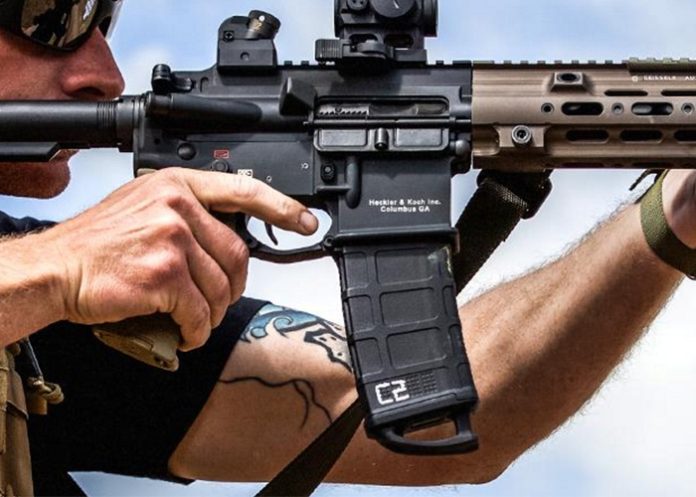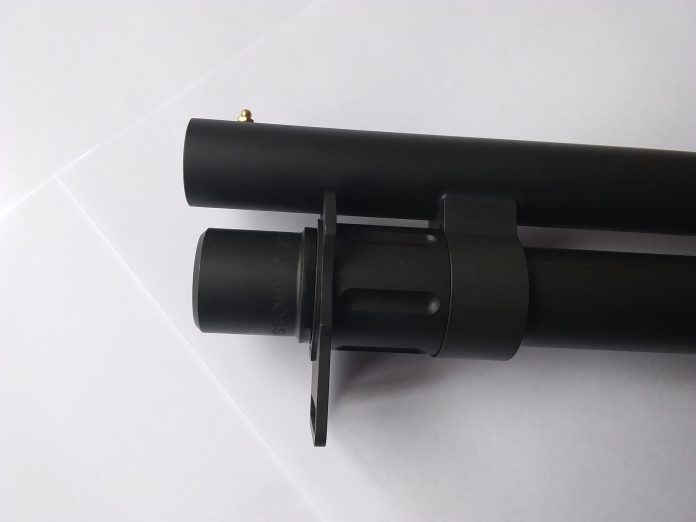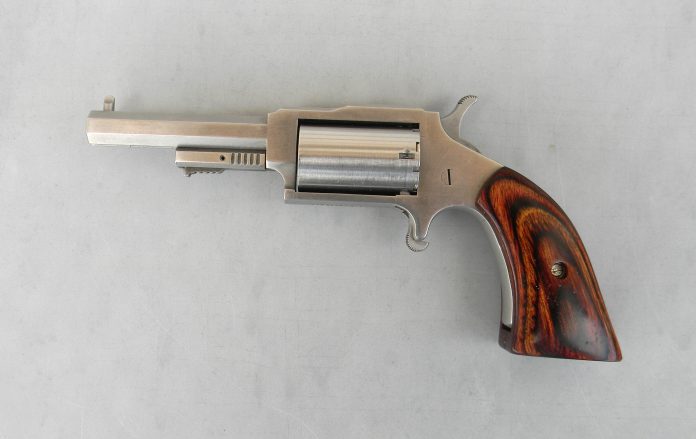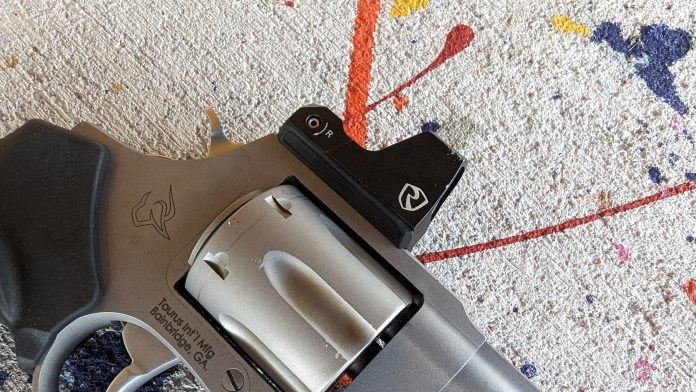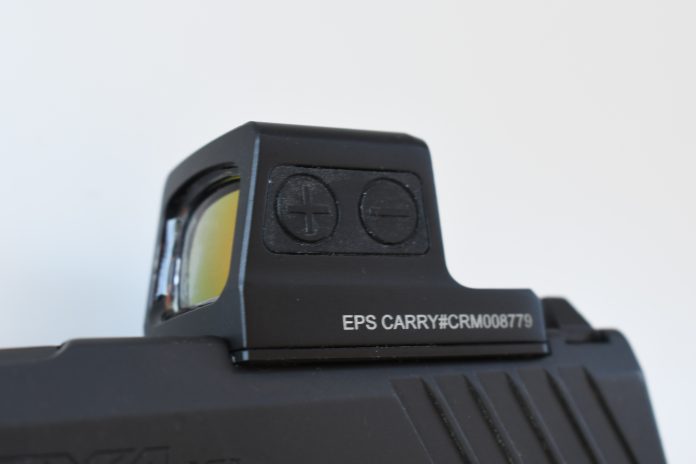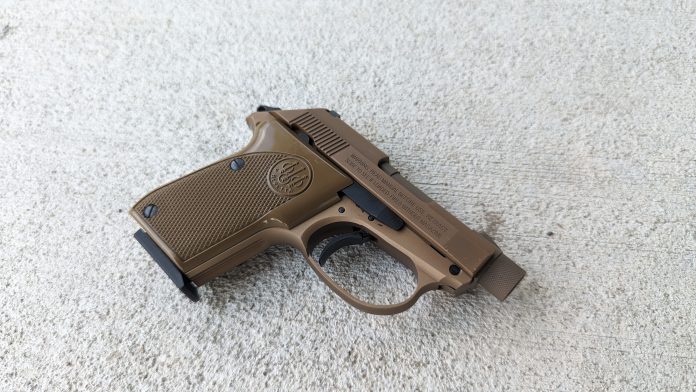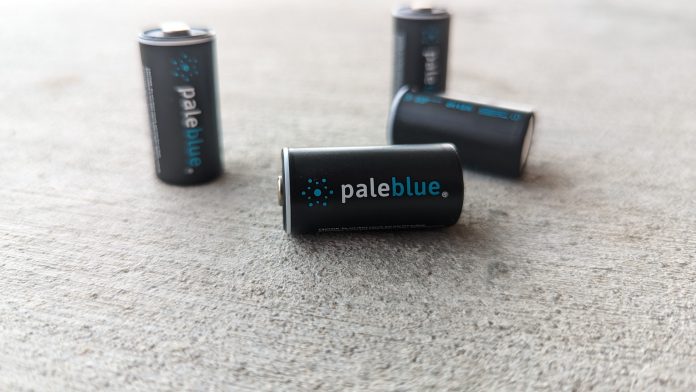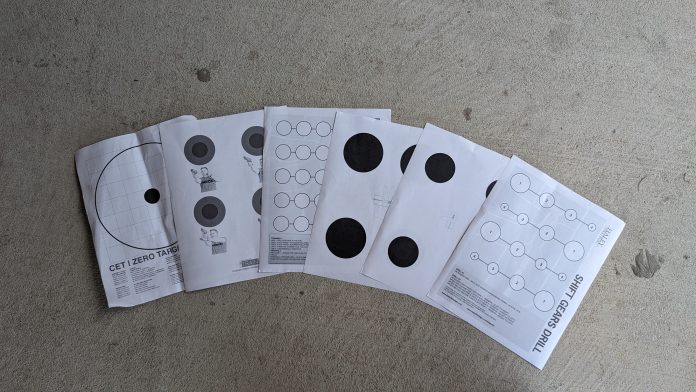Marking Mags – Why and How
Do you ever see high-volume shooters mark their mags? It seems odd, right? Why would they ever need to write numbers of their magazines? Well, great questions, and today we dive into the why of marking magazines and why it might be a valuable idea for you to give a spin.
Why Marking Mags Is Useful
The main reason why magazines are marked is to be able to tell one from the other. Most shooters will number their magazines so they know that this is PMAG 1, 2, and 3. Being able to identify the magazine is crucial in case one begins to fail. Let’s face it: all magazines basically look alike, and in the midst of training, competition shooting, and similar endeavors, it’s easy to experience a malfunction, remove and replace the magazine, and keep going.
If one malfunctions, you can notate the number and keep track of it. One malfunction doesn’t mean much, but if the magazine consistently malfunctions, you’ll know which magazine is problematic and to remove it. You might need to fix the spring the follower or just toss it or regulate it to a training magazine.
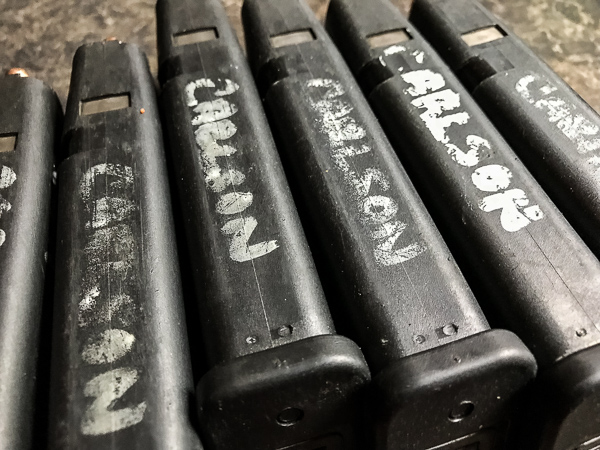
That’s one reason, but marking goes beyond that. You might be using a series of very similar magazines for a variety of calibers. Dedicating magazines to .300 Blackout helps you prevent your 5.56 gun from going boom. I also like the Endo 9mm magazines that use a PMAG as their host. These mags all have a big nine on the side. I joke that they are Red Nine magazines.
You might also want to mark your magazines based on what they are used for. Are they training mags? Duty mags? Defensive mags? It might be worth marking them. My Glock mags from KCI don’t look much different than my OEM mags, but I don’t want to mix them up. If you take an AR class there will be mags everywhere and a set of initials makes them easy to separate.
Mark ‘Em Up
Marking mags is pretty easy. You can do it with a paint pen pretty easily. Magazines like the Gen 3 PMAGs have a dot matrix that makes it easy and convenient to mark. Birchwood Casey makes paint pens, and so does Sharpie. That’s the easiest way and can be done on demand.

Another easy way is if you just want to mark them with your name or something similar you have them laser engraved. It’s a bit fancy, but permanent and admittedly looks nice. It’s like monogramming but for your gun’s feed device. You’ll be the classiest gent in class. It’s not exactly complicated to get your magazines marked and can be a valuable task to complete.
Prism Tricks
Travis wrote a bit on this not too long ago, but for those of us more visually inclined 9-Hole reviews has a video here on the magnifier trick of using a scope through an RDS or Holographic optic.
As mind breaking as it seems the concept is simple. A magnifier is simply a reticule free scope. Putting a regular fixed scope behind the dot can work the same way as long as the objective lens can gather the light properly from the dot. Neat solution to pre-LPVO mainstream life and times.
Lehigh Ammunition Testing
The test of science isn’t asking you to believe but presenting the results of testing and letting you make your own conclusion. I have tested Lehigh ammunition extensively and came to the conclusion that these loads feature good quality control feed reliability and accuracy. Lehigh began manufacturing match grade copper bullets and today Lehigh ammunition is owned by Wilson Combat. The load I was most interested in was the .45 ACP 170 grain hollowpoint. My carry gun is a Springfield 1911 and I enjoy running different high quality load in the pistol and gauging performance. The 170 grain load breaks just over 1,100 fps according to the RCBS chronograph. Recoil is about the same or less than the usual 185 grain .45 ACP loading. Accuracy is good. Expansion in water jugs and wet paper is startling- 1.2 to 1.5 inch and 8 to 10 inches of penetration in this less than scientific media.
I also fired the 135 grain .45 ACP Lehigh. A fluted bullet designed to chop tissue and create damage by fluid force is more difficult to qualify than an expanding bullet. Expansion is obvious, fluid damage is not. These bullets penetrate less than a full metal jacketed bullet and cause a lot of damage in water jugs and gelatin. Advertised at 1250 fps this load clocked at 1190 fps. The Savage 1911 pistol exhibited good accuracy, firing both off hand and from a braced firing position. Powder burn is clean with limited muzzle blast.

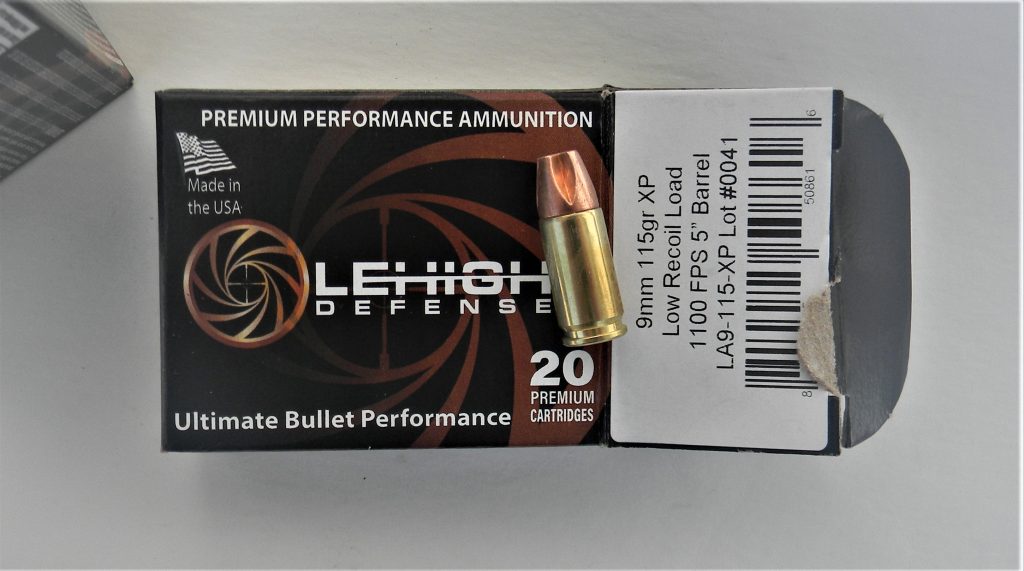
Next I broke out the Springfield Echelon for testing 9mm Luger loads. First up was the 105 grain fracturing hollow point. Velocity is 1193 fps on average in the Springfield. I also fired a few rounds in the SIG P210. This pistol registered 1270 fps and an associates long slide Glock 34 delivered 1301 fps. Certainly plenty of velocity. Expansion in fourteen inches of water is a solid consistent .80. From the SIG a bullet went fifteen inches and .84- statistically meaningless but impressive. I cannot think of a 9mm load that has given me more confidence in testing.
The 90 grain all copper fluted nose load came up next. The XD load offers significantly lower recoil than most 9mm defense loads. Penetration is good and at 1349 fps it isn’t a slow load. A 90 grain bullet simply produces less recoil energy than a heavier bullet. I was able to take pot shots with this combination at a long 50 yards on steel gongs. You could hear the resounding thunk as the bullets hit the eight inch gong a little more than half of the shots fired. I like this load and its easy combination of light recoil and high velocity.
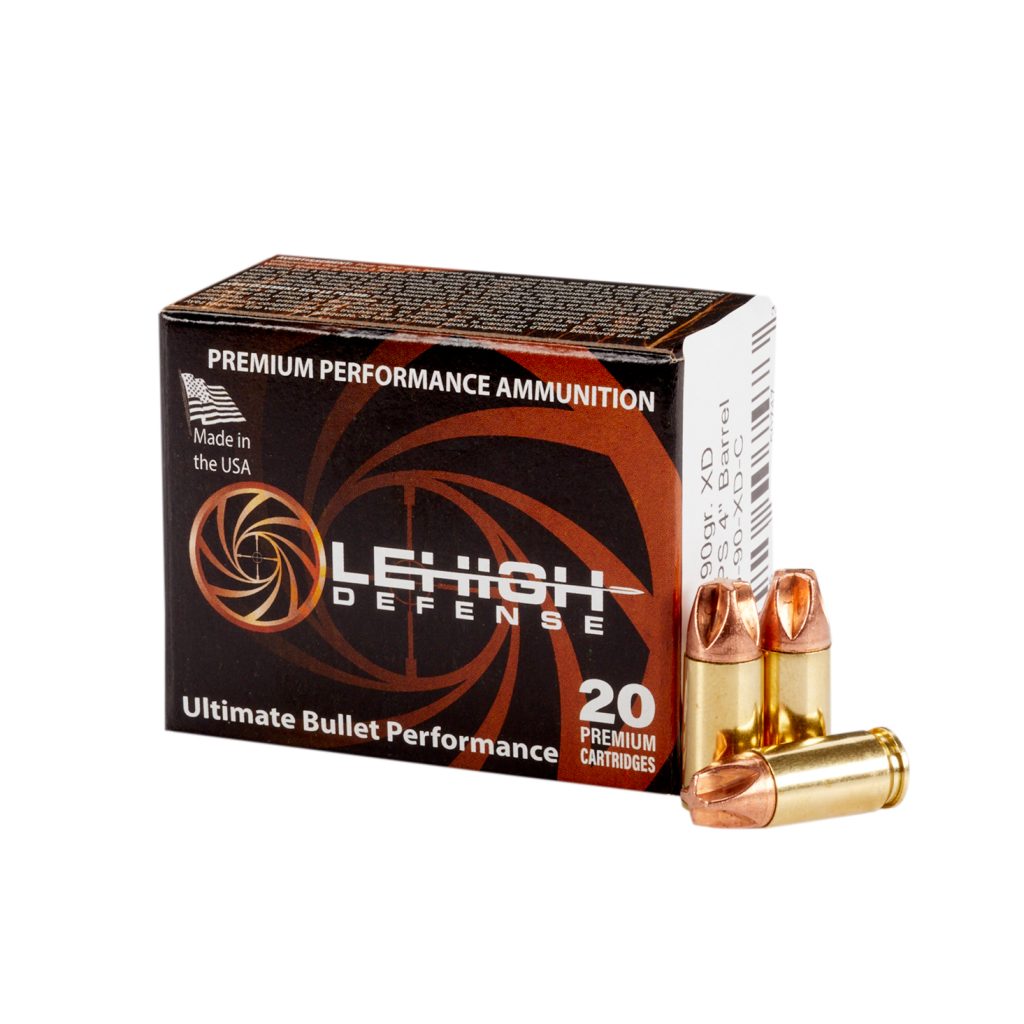

I also fired the CF +P loading. An all copper bullet is longer than a lead core bullet and as a result more of the powder space is taken up by the bullet shank. As a result while real speed may be achieved with all copper bullets that are a bit lighter for the caliber heavier bullets cannot be loaded as fast as the 90 to 100 grain bullets. As a result this 115 grain bullet clocks 1150 fps in the Springfield about average to below average velocity for a 115 grain 9mm. Just the same the all copper bullet treatment is accurate and make for good penetration. The controlled fracturing design with its all copper bullet serrated in order to ensure expansion is a reliable mechanism that produces consistent results. This load is also the single most accurate of the 9mm loadings. Firing from an MTM Caseguard K zone firing rest and taking every advantage for accuracy and with no time limit two five shot groups were fired, one at 15 yards and one at 25 yards. The 15 yard group was 1.4 inch while the 25 yard group was 2.1 inch. This is excellent accuracy for service grade ammunition.
The 115 grain XD 9mm low recoil load proved interesting. A solid copper fluted bullet may cause more disruption at high velocity but then it doesn’t need high velocity to do its chopping effect. And lets face it some loads simply kick a little too much for lighter pistols. A Shadow Systems compact or FN Reflex may not be the rest choice for +P loads. This load clocks 1089 fps in the FN Reflex 1101 fps in a Glock 19 1121 fps in SIG P210 and 1090 fps in the Springfield Echelon. Low recoil loads are not designed for a great deal of energy. This carefully designed combination offers good function and accuracy. There is a lot to be said for accurate delivery and fast recovery.
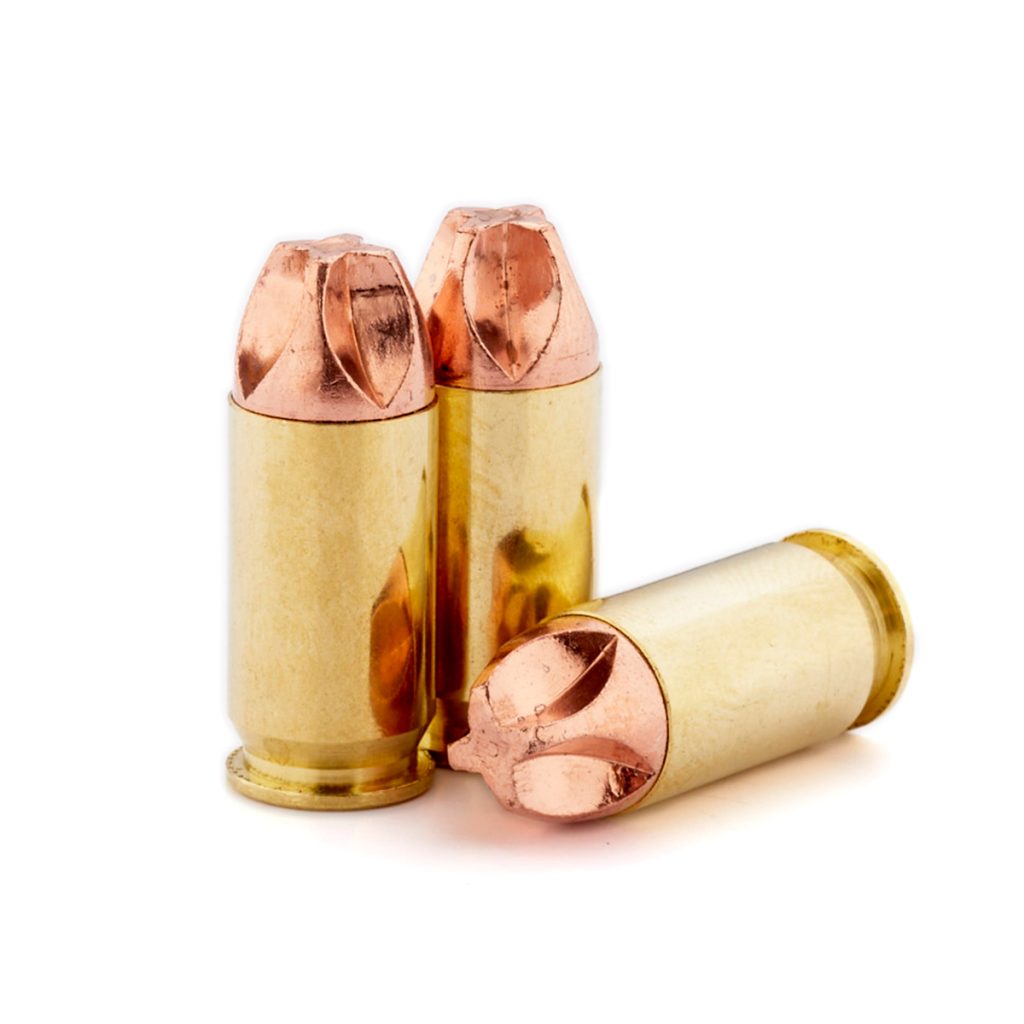
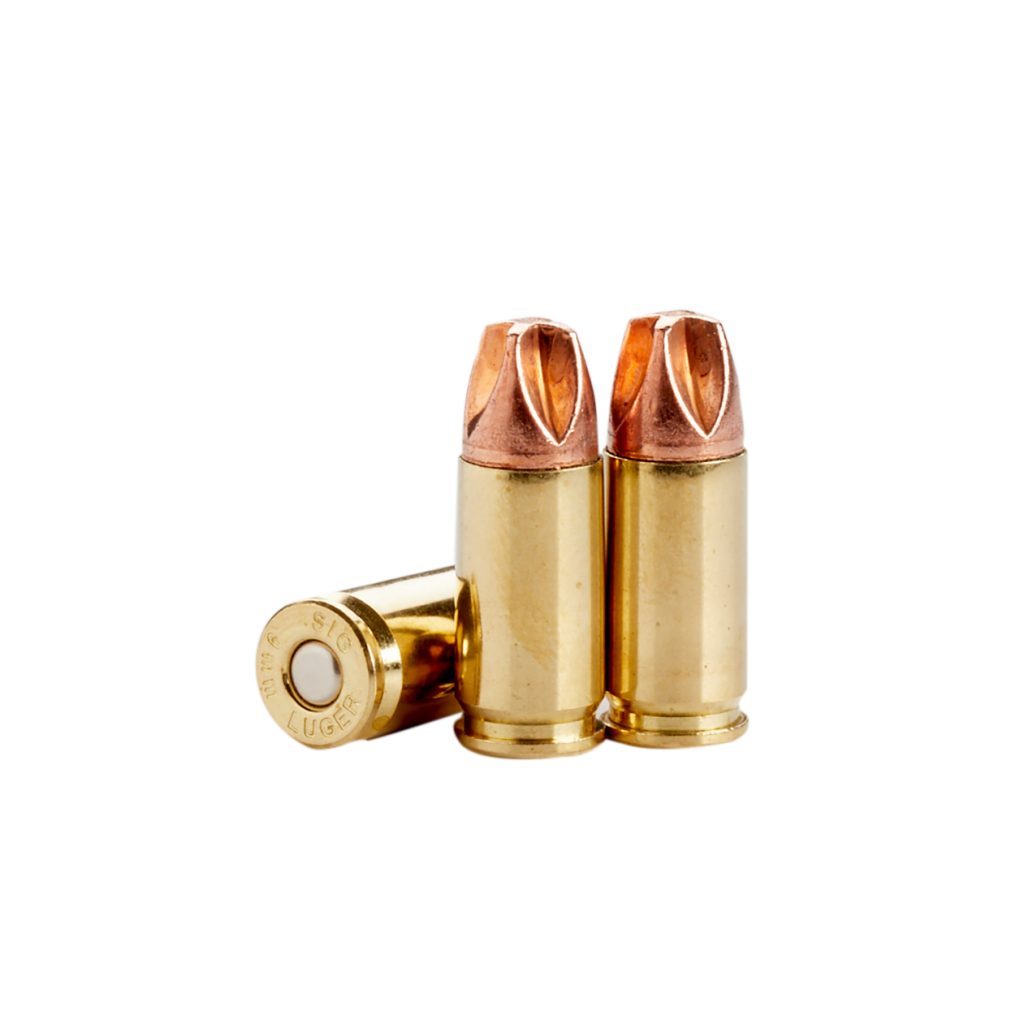
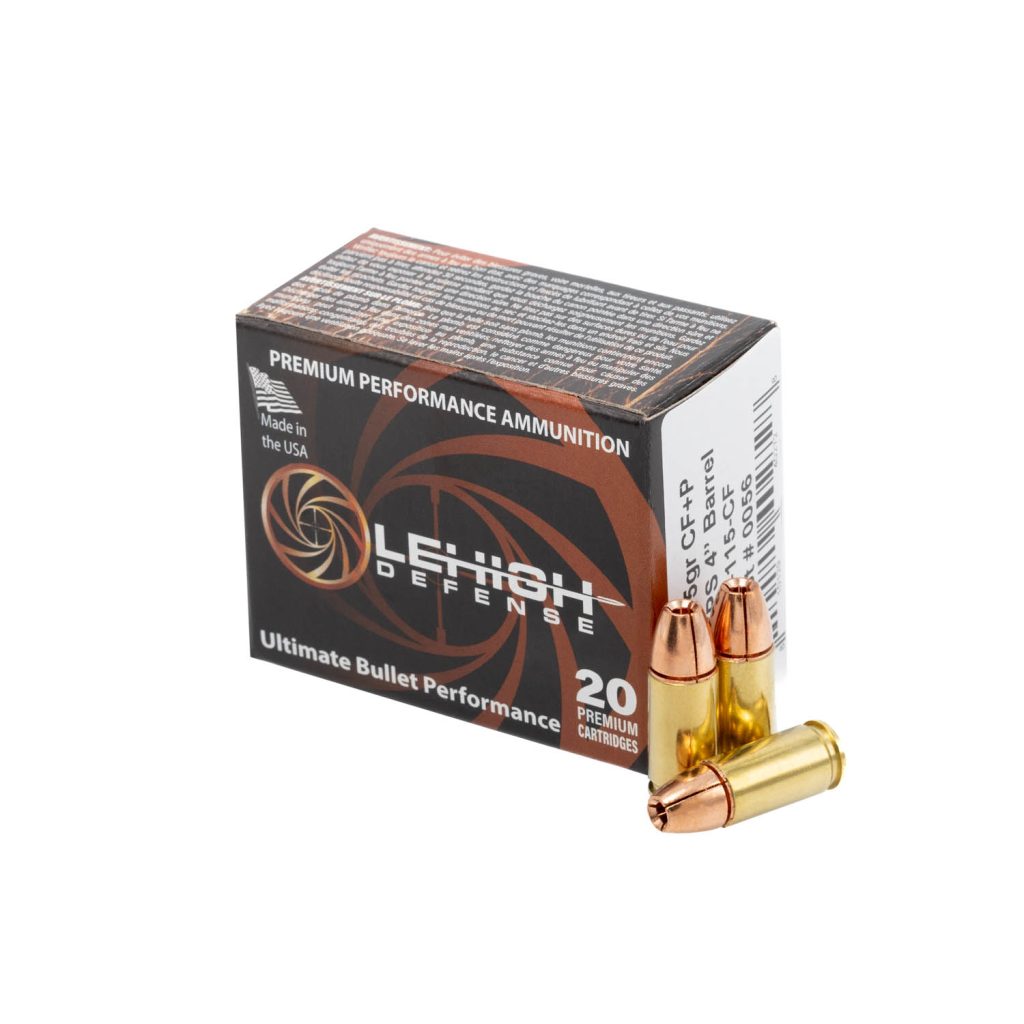
In firing several hundred Lehigh ammunition loads I admit perhaps I am short on wound potential testing although my tests of the hollow point loads certainly proved these are good choices for personal defense. The bottom line in choosing ammunition must be reliability. These loads proved reliable accurate and clean burning a wide range of handgun. That is the bottom line for choosing defensive ammunition.
What You Need to Know About Shotgun Tube Extensions
Shotgun magazine tubes are an interesting way to store ammo. It sits below the barrel and holds anywhere from three to 12 rounds, depending on how crazy the gun and manufacturer get. Typically, they hold between four and eight rounds. There is a big difference between four and eight rounds, and if you want eight rounds instead of four, you need to add a tube extension.
Tube extensions typically thread onto your shotgun’s existing tube and make things just a little longer, and extra length means extra ammo. Adding a magazine extension is pretty simple, but doing it the right way takes a little extra know-how. The first thing you should know is that while tube extensions are fine, if you have the option to use a complete replacement magazine tube, do that instead of using a tube extension.
Guns like the Benelli M4, for example, tend to work best with seven-round tubes rather than a five-round tube and a + 2 extension. A complete tube replacement is the way to go if that’s an option. It’s a simpler, more reliable, and overall better option.
Tube Extensions 101 – Know Your Gun
Sometimes, adding a tube extension isn’t always easy. You’d think it’d be a simple process, but alas, complications arise. First and foremost, you should make sure your gun can accept an extension. Guns like the Mossberg 500 cannot, but the 590 can. On guns like the Remington 870, you might run into a dimpled magazine tube. Why does Remington dimple their magazine tube?
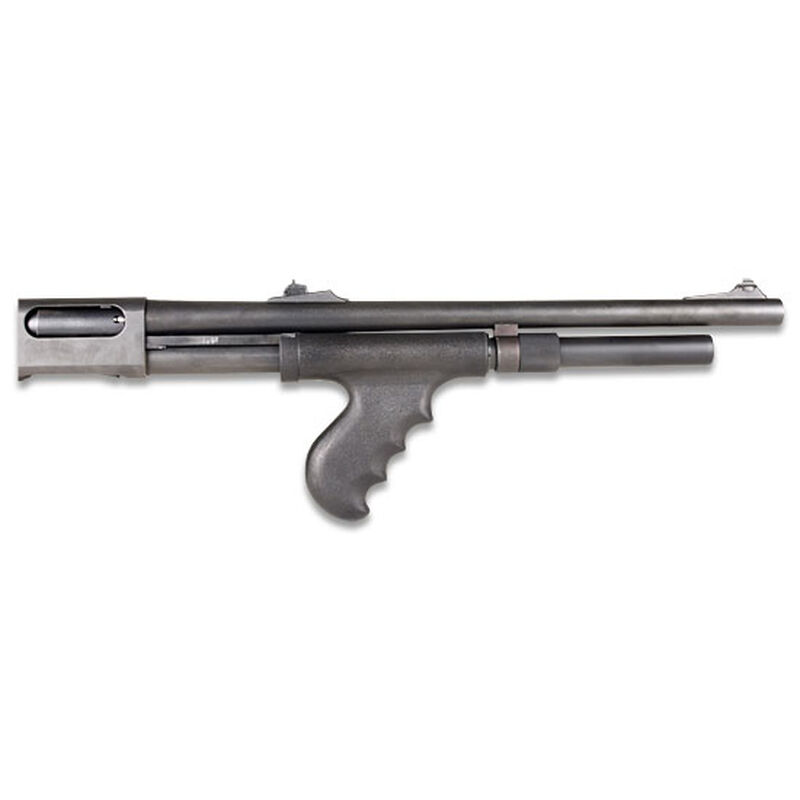
Because they hate you? I honestly don’t know. You can use a swage to drive it out and solve the problem or even file it off. Other guns may have generational differences that make adding an extension impossible. Research it a bit before you dive in.
Go With Metal
If it’s a defensive gun, go with a metal magazine tube extension. Competition guns often use lighter-weight tubes, and that’s fine. Tactical guns should be rugged. Polymer can be plenty tough, but I’m not aware of any high-quality shotgun company making polymer tube extensions. Metal tends to be a better way to go for smooth feeding, as well as resistance to the elements. Plus, wrench flats allow it to get quite tight.
Springs Matter
If you’re extending your magazine, you’ll need a better spring. Most will come with the spring you’ll likely need, but if not, you need to find the right option. You’ll need to know your shotgun’s capacity after you install the extension. Check out Wolff for good springs for shotguns. Or good springs for anything, for that matter.
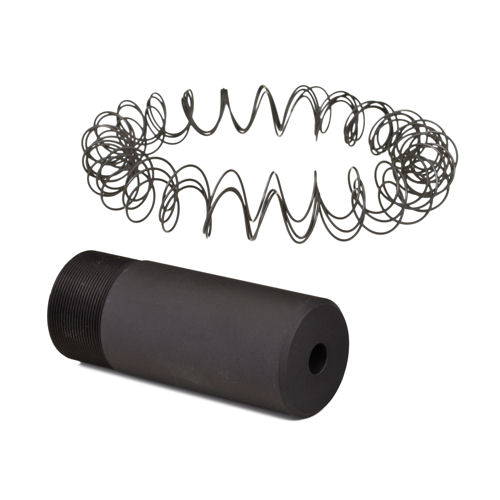
Followers Matter
Followers also matter. An anodized aluminum follower that’s ultra-smooth tends to work best with magazine extensions. Where the magazine meets the tube extension is a big hangup spot for your followers. I personally suggest the SMRT follower from Aridus. It’s specifically designed for this purpose and for more.
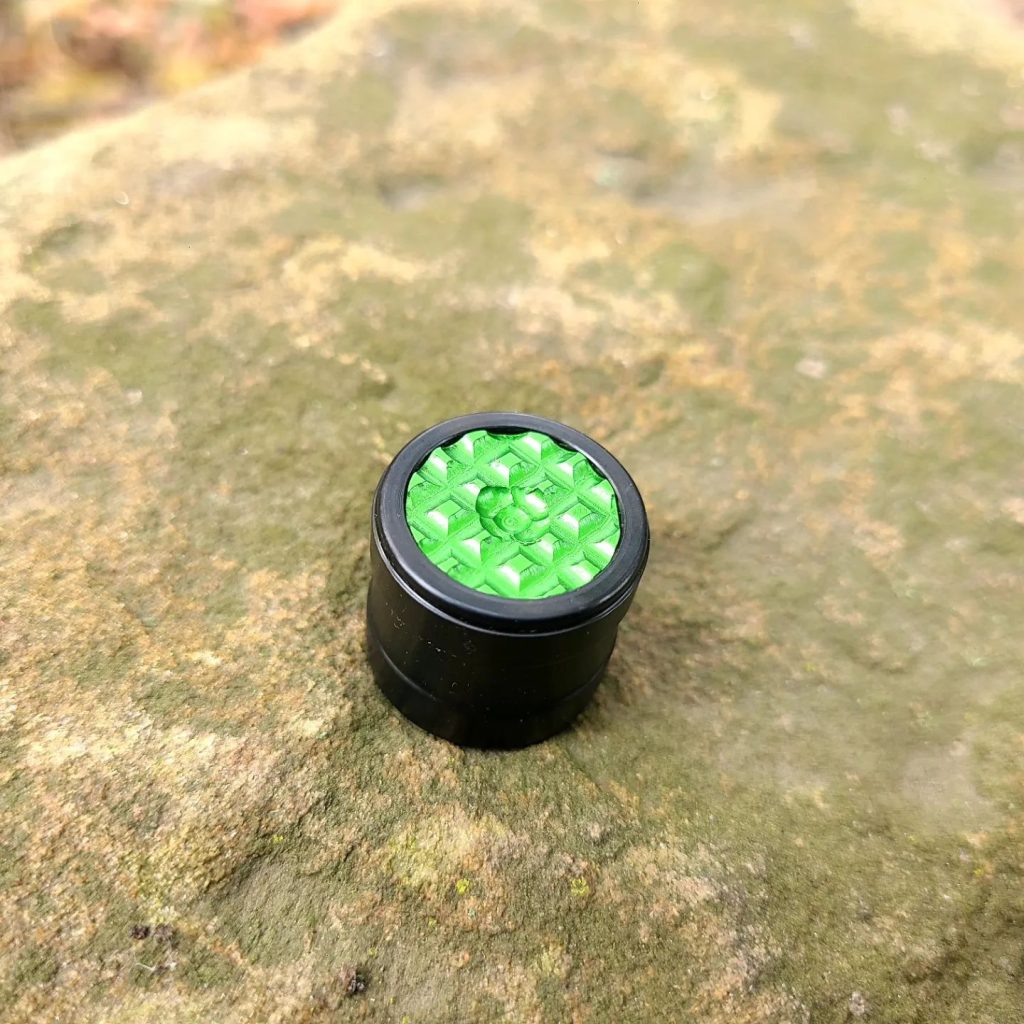
Barrel Clamps
Do you need a barrel clamp? I wouldn’t say it’s an absolute requirement. However, a barrel clamp does provide a little extra stability to the magazine tube. It’s not necessarily something you’ll notice in a self-defense situation, but it’ll help ensure the tube extension doesn’t bend or fail. With nothing between the barrel and the tube, it’s easy for a sling or anything else to get between the two and create problems.
Get a Paint Pin
Once you’ve installed the tube extension and gotten it locked down tight, use a paint pen to mark where the tube extension meets the tube. This is your index mark. This allows you to observe if the tube begins to loosen and can tighten appropriately. Once you start shooting a lot, you’ll be surprised by how much that tube extension will start to move. Once it gets too loose, you’ll run into all manner of malfunctions.
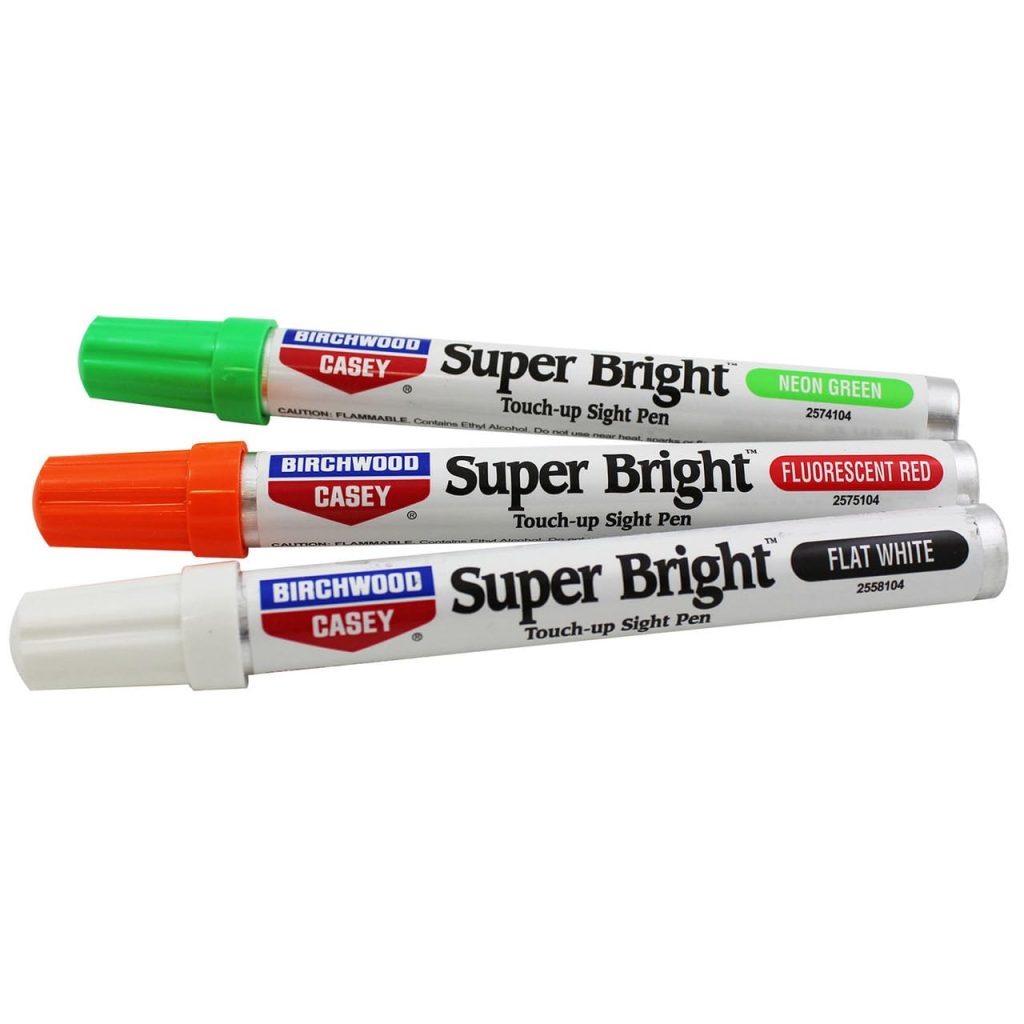
Tubed Up
A magazine tube extension allows you to pack a few extra rounds into your gun. However, extra ammo ain’t worth a damn if the gun malfunctions and chokes due to the tube extension. Like any other part of a firearm, it needs to be properly installed, and you have to apply a little forethought to everything. Don’t be lazy. Think it through, and do it right.
NAA Sheriff .22 Magnum
I am not recommending that you carry such a small caliber revolver for personal defense. I will posit there is sometimes a place for it. A good friend found a place for a small handgun. Hemingway’s comments on meeting a great woman or two in your life made quite an impression on me. One that definitely qualified is a woman I have not seen in thirty years. Amanda was and still may be a psychiatric nurse. During the course of some incidents in which our paths crossed we became quite close. She told me that she loved the people she worked with or she could not do the work but she wasn’t going to let them kill her. She carried a Colt .25 ACP in a sewn in bra holster. About the same time a nurse walking out of the local hospital was assaulted and dragged into a car. She drew a .380 ACP pistol and shoved it into the assailants belly. It fired once and jammed. The assailant seriously injured her and fled although we found him later. He was not seriously injured. A senior I used to walk from a church to her car at night showed me a .22 Magnum derringer she carried, a gift from her late husband, a peace officer. She said ‘I don’t need you!’ These small guns give the user some peace of mind and while it may be misplaced I suppose it is better than no gun at all. Although depending on the range I would perhaps prefer a good sharp stout knife.
A revolver that seems to be owned by practically every handgun crank although they don’t always admit carrying it is the North American Arms single action revolver. It is well made of good material. Some of the smallest examples are difficult to use well. Most are solid frame revolvers with a base pin that is removed to unloose the cylinder from the frame. There are break top and swing out cylinder versions and interchangeable cylinder revolvers as well. My example is a much improved shooter. The Sheriff features a three inch barrel and boot grip. The Sheriff features the standard base pin and cylinder design. The base pin must be pulled forward to allow removal of the cylinder. The cartridges are loaded one at a time then the cylinder is locked back in place. To unload the revolver the same procedure is followed. To safely carry the revolver the hammer spur must be lowered into a safety notch between cylinders. If you are not absolutely certain you are able to be certain you have the hammer properly placed in the safety notch then load only four cartridges in the five shot cylinder. To fire the revolver the hammer is cocked and the spur trigger pressed. The hammer must be cocked for every shot. No trigger guard is needed as the hammer is down and at rest and a press on the trigger cannot cock the hammer. As you may imagine drawing the NAA revolver cocking the hammer and firing must be practiced often to provide any degree of protection.
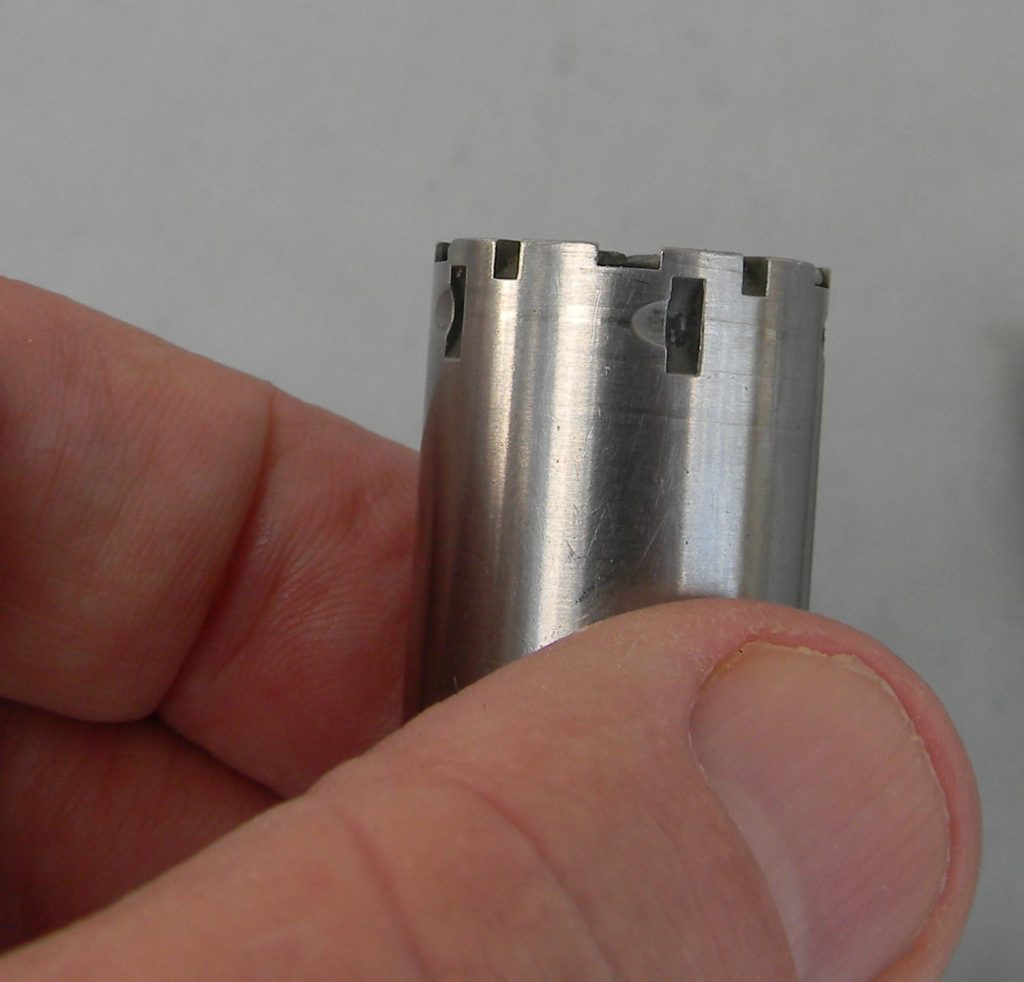
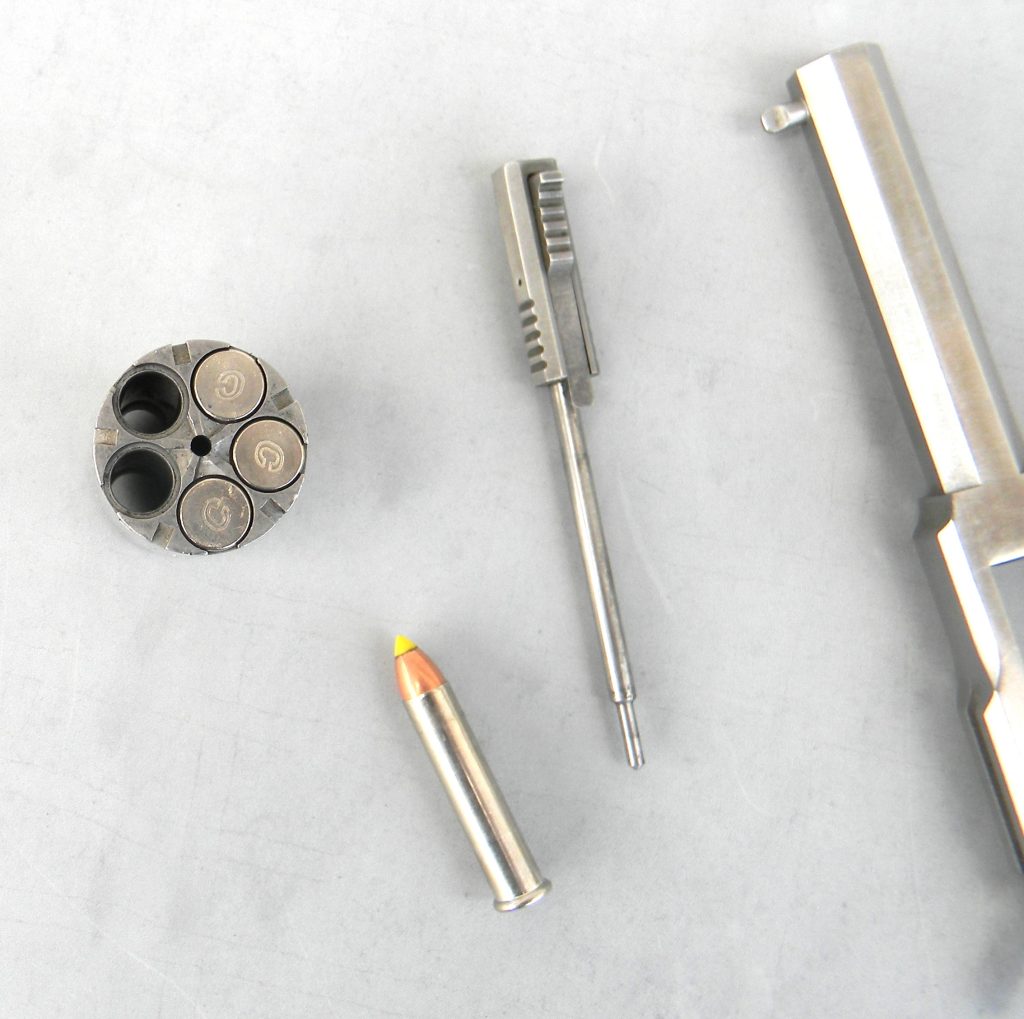
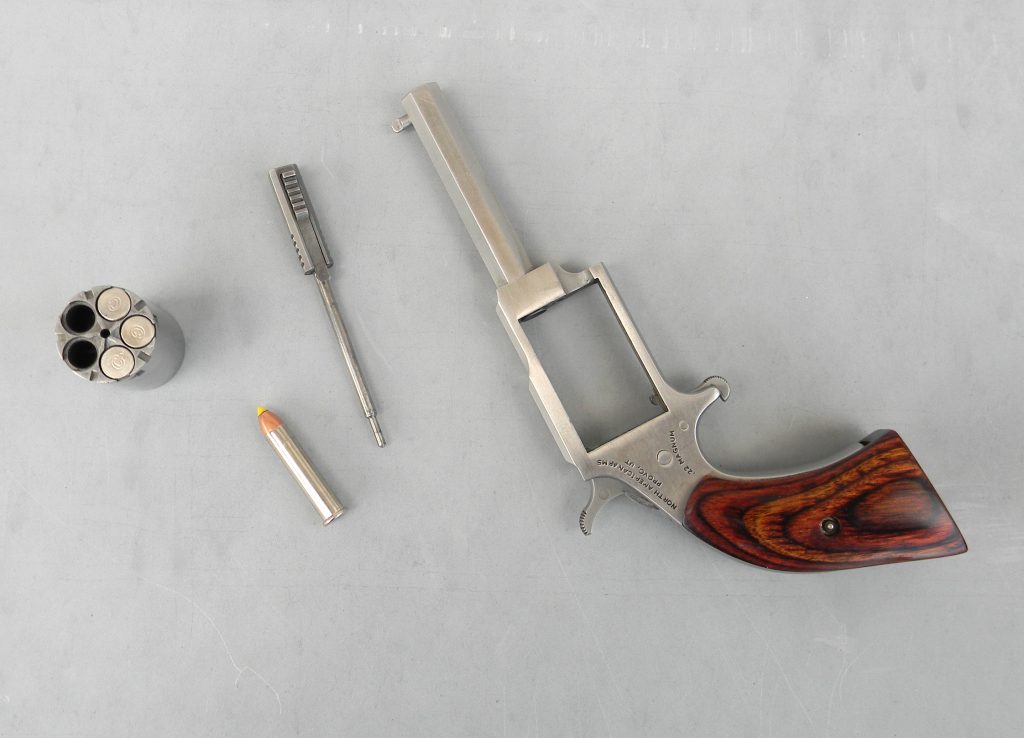
I have fired a number of the NAA revolvers and found the types universally reliable and well made. The problem is the power deficit and the difficulty in using them well. They are popular as I suppose a kind of handgunner’s fashion accessory. Some feel that flash and blast will deter a bad guy. I think a bad guy with a gun will be encouraged to fire more quickly and more accurately when they realize they have been shot at or to move in and crown you good if unarmed. It is best to hit the adversary hard in the right place. That said I come from a profession that relies on backup guns. Weight and expense have shooters looking for a solution and one that just might save a life. The Sheriff is a neat trick. These little guns are well made like good clockwork. The sights are very simple- a front post and a square notch rear. I have labeled the originals with their 1.9 inch or shorter barrel a contact weapon. They would be used much as if you were giving your attacker a nasal inhaler. The Sheriff is a far different story. I am actually able to get hits far past conversational distance. The trick is to take a firm grip. As you bring the revolver up toward the target from concealed carry cock the hammer as you bring the front sight toward the target. When the front sight breaks the plane between the eye and the target press the trigger. At three to five yards you will get a center hit with practice. At contact range as befits the .22 Magnum’s backup role it may be easier. At five yards slowing down and taking my time to get a hit the revolver groups five shots into about two inches easy enough. I really stretched the envelope and tried a few shots at ten yards. I used an unrealistic braced barricade position. I aimed as best I could and pressed the trigger. Being very careful I managed a four inch group at ten yards. The group was about three inches high, the result of muzzle flip. This is impressive for the weapon involved. In favor of the NAA Sheriff is smoothness and reliability. Power not so much.
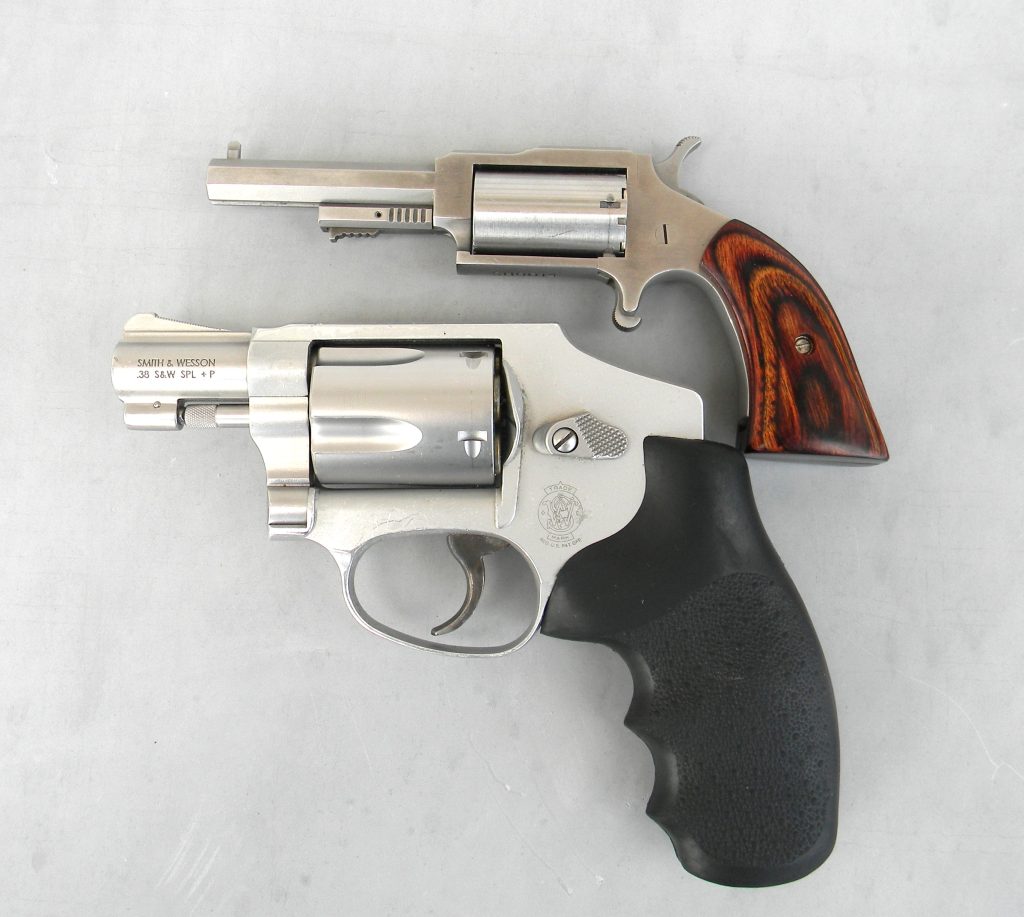

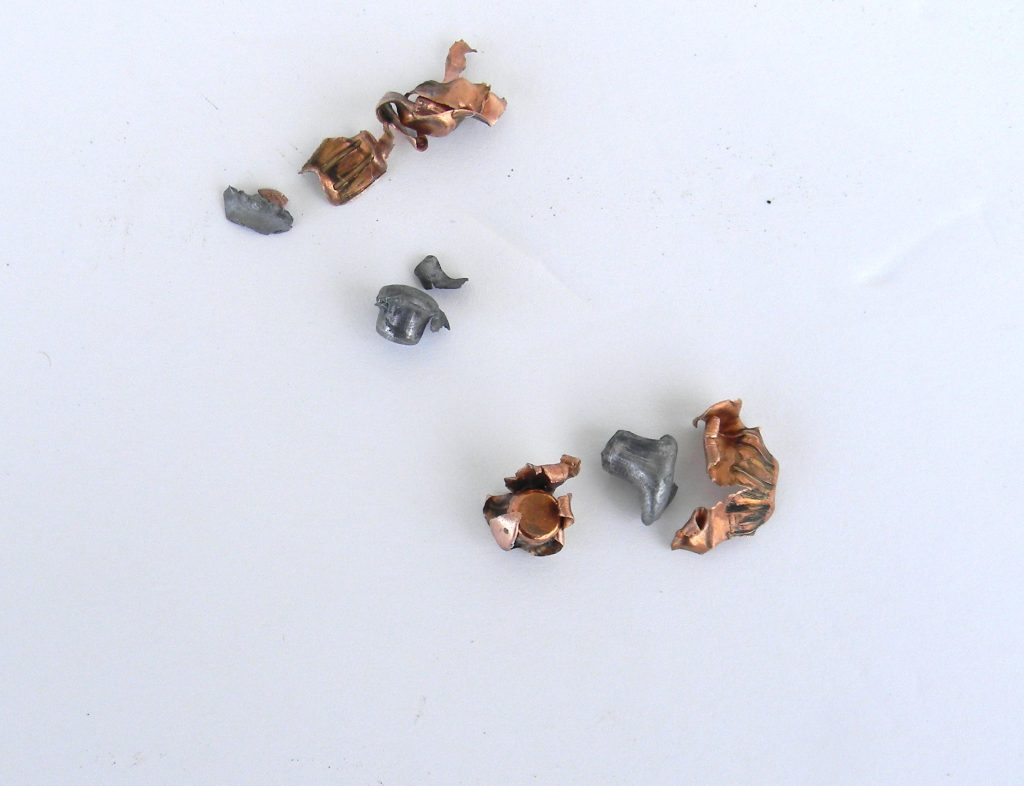
The revolver is reliable with a wide range of ammunition. Most of us rely on the CCI Maxi Mag for its reputation for reliability. Do not use 30 grain loads as penetration is poor. Fairly recently Hornady developed the FTX .22 Magnum Critical Defense and Federal gave us the Punch. These are purpose designed defense loads. I might still opt for a non expanding .22 Magnum load and rely on penetration alone but just the same these loads give the best balance of penetration and expansion possible in this caliber. Each shows good expansion to about .32 to .35 caliber. Velocity is just at 1100 fps. After a 100 round evaluation I find the NAA Sheriff reliable and perhaps it fills a niche as a backup or third gun. It is a fun gun and challenging to use well. If it fits your needs practice and be certain to keep in mind the limitations of range, power, and accuracy.
- Caliber .22 Magnum
- Five shot cylinder
- Barrel Length 3 inches
- Weight 8.3 oz.
The Riton 3 TACTIX MPRD 2
It will be a long time before we get one universal footprint for duty-sized handgun optics. Trijicon, SIG, and Leupold seem to be fighting for supremacy in that realm. Luckily, the small dots market has decided that the Shield RMSc footprint is the way to go! Except for the RMRcc, both you and I forgot that it exists until right now. One such optic competing for small optic supremacy is the budget-priced Riton 3 Tactix MPRD 2.
One of the best ways to make use of my time and ammo is to try and review multiple products at the same time. I’m currently reviewing the Taurus 856 Defender TORO, and since it’s optic-ready, I installed the MRPD 2. Tell me that’s not synergy! Let’s dive into this little optic and see if its budget-ready price point is worth the squeeze.
The 3 Tactix MPRD 2
That’s quite the name. The 3 Tactix MPRD 2 fits the Shield RMSc footprint, which made it simple to attach to the 856 Defender TORO. While the MPRD 2 is budget-priced, the quality is surprisingly nice. It’s an all-metal body with glass lenses. Typically, affordable optics offer you polymer lenses with polymer bodies, but that isn’t the case here.
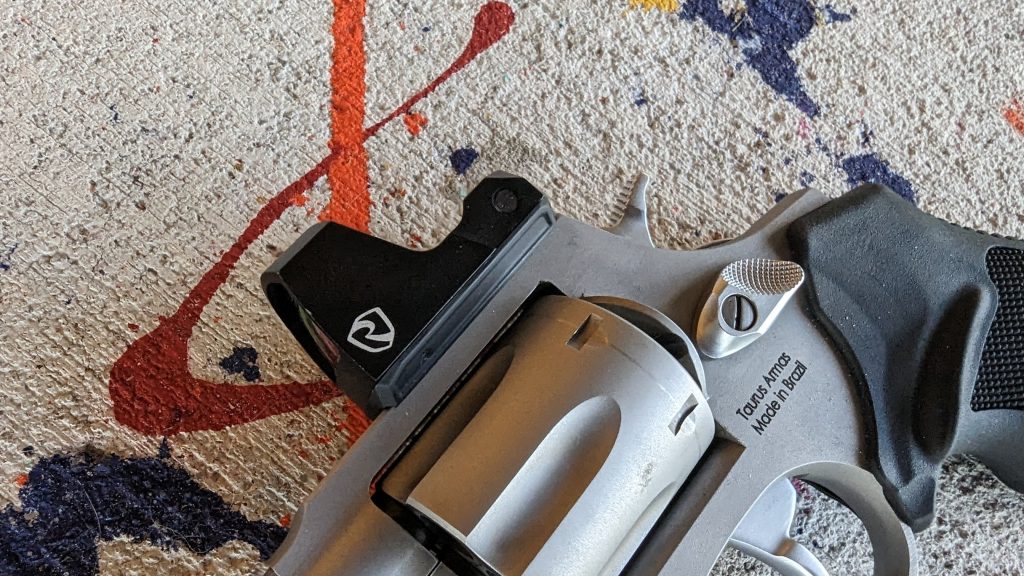
A quick look will reveal an absence of buttons present. This optic has none. Adjustments are made automatically by reading the ambient light around the optic. This works fine most of the time. Where you’ll run into issues is being in a dimmer environment and being forced to aim into a brighter environment.
This makes it tough to see the reticle. That reticle is a bright 3 MOA dot. It’s fairly crisp and round. It’s surprisingly nice for a budget optic. The reticle itself can dim to night vision levels and get bright enough to be easily seen in the high noon of Florida. The optic lasts 50,000 hours and does have an auto-shutoff, shake-awake feature. This shuts the optic off after three minutes with no movement. The feature set is a good mix of what we expect from budget optics and quite a few we expect to see from higher quality options.
Optics on Revolvers
The 856 Defender TORO prevents an odd problem with optics. Because it sits so high above the bore, it can be tough to get zeroed. You need enough elevation to get it done, and luckily, the MPRD 2 provides that.
I had no issues getting the optic zeroed to the gun, and before I knew it, I felt like a high-tech Private Eye sending round after round of .38 Special into a variety of targets. The adjustments are a bit of a pain. There are no tactile or audible clicks. This makes adjustments more of a feeling than an exact science. Luckily, I zeroed in at twenty yards, and it wasn’t too difficult to get some Speer Lawman into a palm-sized group.

Once zeroed, I had a blast sending lead downrange with the 856. It was quite a learning experience. The MPRD 2 held zero without a problem. On a revolver, there is no slide to cycle, so the optic doesn’t suffer from aton of Gs. However, even if it did, I’m positive the Riton could handle it.
Blasting Away
The Taurus 856 Defender TORO and the Riton MPRD 2 and I have taken quite the trip together. It’s been subject to plenty of live fire with both hands and one at a time. I’ve bench-rested and rapid-fired. I’ve worked double taps and well-aimed headshots. Regardless of why I did it or how fast I did it, the Riton MPRD 2 held it together.
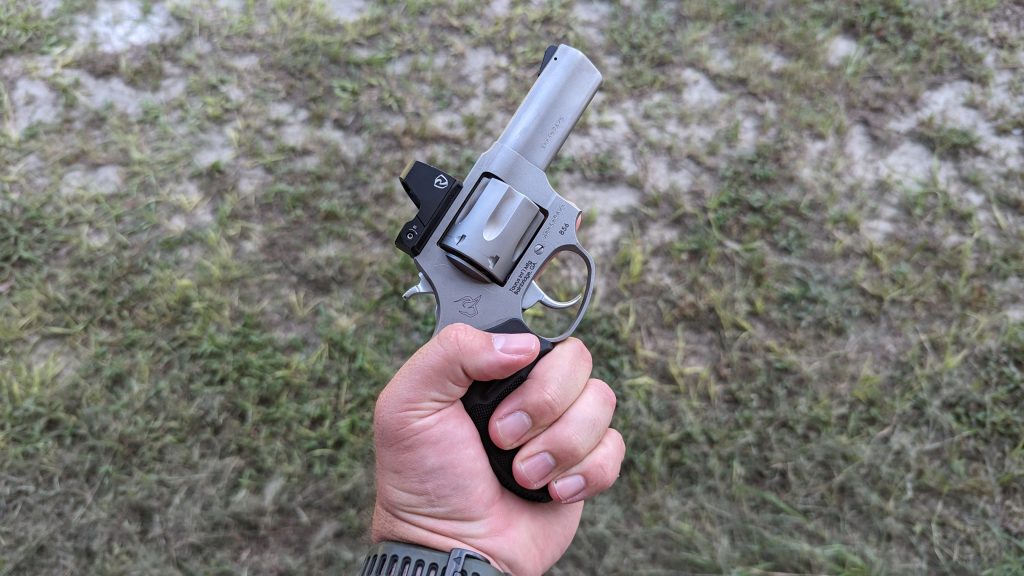
The dot’s zero never shifted, and with a lot of practice, the gun and I became quite familiar with each other. As I learned the double-action trigger, I became quite accurate, and after a shot was fired, I could tell where it was by where the dot rested after the recoil impulse. Every time, it was dead on. A 3-inch barrel leaves some burning gunpowder, and it tends to gather on the lens. A quick wipe makes that a non-problem.
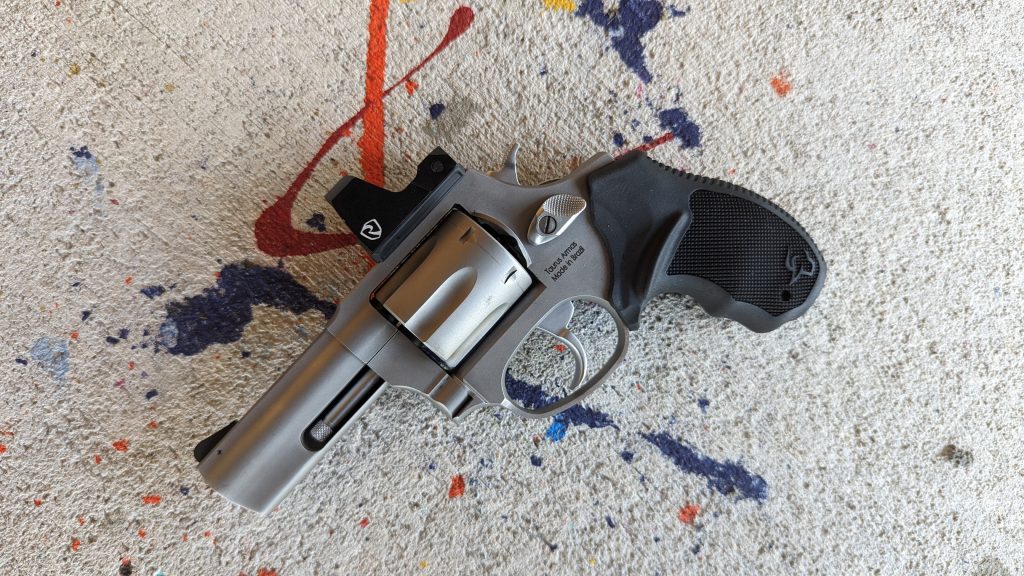
Speaking of, the clarity is quite nice. There is a blue tint, but it’s not obstructive. Seeing the dot is simple, and that dot stays consistently round at all but the dimmest night settings. At the lowest settings, it gets a little blurry, but I don’t shoot in the dark much.
Worth the Change
A few hundred rounds later, the MPRD proved to be quite well made. It surpassed my expectations by quite a bit. Sure, the lack of manual controls isn’t my favorite, but the optic proved functional. The brightness adjusted easily and quickly with light changes. The metal body and glass lenses are a nice touch, and it’s a well-put-together optic for very little money. It certainly works well enough to be mounted on a concealed carry revolver.
The Holosun EPS Carry
The Holosun EPS Carry is currently the smallest enclosed emitter reflex sight on the market. Like the Holosun 407-K and 507-K before it, the EPS Carry also makes use of the “slimline” Holosun-K footprint. The EPS Carry along with the slightly larger EPS stand out amongst enclosed emitter reflex sights due to the fact that they were designed with a lower deck height. This means that EPS series optics sit slightly lower than “normal” when mounted. Depending on the gun and the milling cut, the EPS series may sit low enough that standard height iron sights are able to be used. While this review is solely about the smaller EPS Carry, I do want to bring up the standard sized EPS one more time, because I think this bears mentioning and can avoid some confusion. Both the bigger EPS and the smaller EPS Carry use the exact same Holosun-K footprint in spite of their size differences. Holosun actually includes a thin Trijicon RMR-footprint adapter plate with the standard EPS so that it can be directly fastened to any Trijicon RMR footprint surface. In a similar vein, Holosun also includes a similar plate for the EPS Carry, but this one fits the Shield RMS-c footprint, which is more or less the “standard” when it comes to any of the slimline guns regardless of make and model (well, currently in 2023 it is). In fact, when I installed the EPS Carry on the Taurus GX4XL, I used this conveniently-included plate as Taurus cuts the GX4 series for the Shield RMS-c.
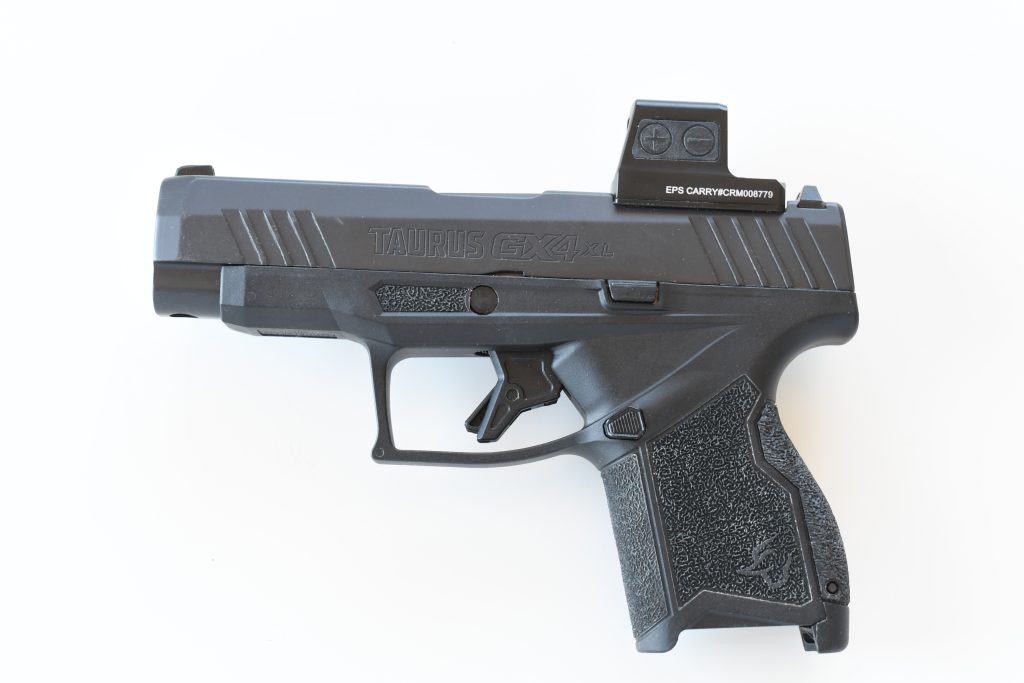
HOLOSUN EPS OVERVIEW
The EPS Carry can be had with red or green LEDs and an MRS (multi reticle system), fixed 2 MOA or 6 MOA dots. The unit that Big Tex Ordnance kindly loaned me is the MRS version, which has three different options: a 32 MOA ring + 2 MOA center dot, an empty 32 MOA ring or a plain 2 MOA center dot. I think that the combination reticle works very well on a micro-dot that’s paired with a smaller, less precise pistol, and it’s something I want to keep exploring further. The EPS Carry ships in pretty much the same foam padded small plastic case that all Holosun reflex sights include along with the complimentary T10 Torx combination tool that’s useful for adjusting windage and elevation and dealing with T10 screws in a pinch. It’s always a good idea to properly torque all hardware down to recommended specifications for reliability with slide mounted reflex sights. And like with most other Holosun pistol dots, the battery tray can be conveniently accessed from the right side of the unit. The EPS Carry uses a single CR-1620 battery which has an estimated 50,000 hour battery life. The EPS Carry has 12 different brightness levels: 2 for night-vision and 10 for daytime use. Tiny buttons are located on the left side of the unit’s external 7075-T6 aluminum housing, and like any other Holosun optic, on/off, reticle changes, locking and brightness adjustments function in the exact same way. The “roof” of this particular EPS Carry has a row of solar cells, and Holosun makes use of their Solar Failsafe function (not all EPS Carry models have the Solar Failsafe feature). The Solar Failsafe system is designed to power the reticle by gathering ambient light if the battery is dead. Lastly, like many other popular Holosun sights, the EPS Carry also includes Holosun’s Shake-Awake technology.
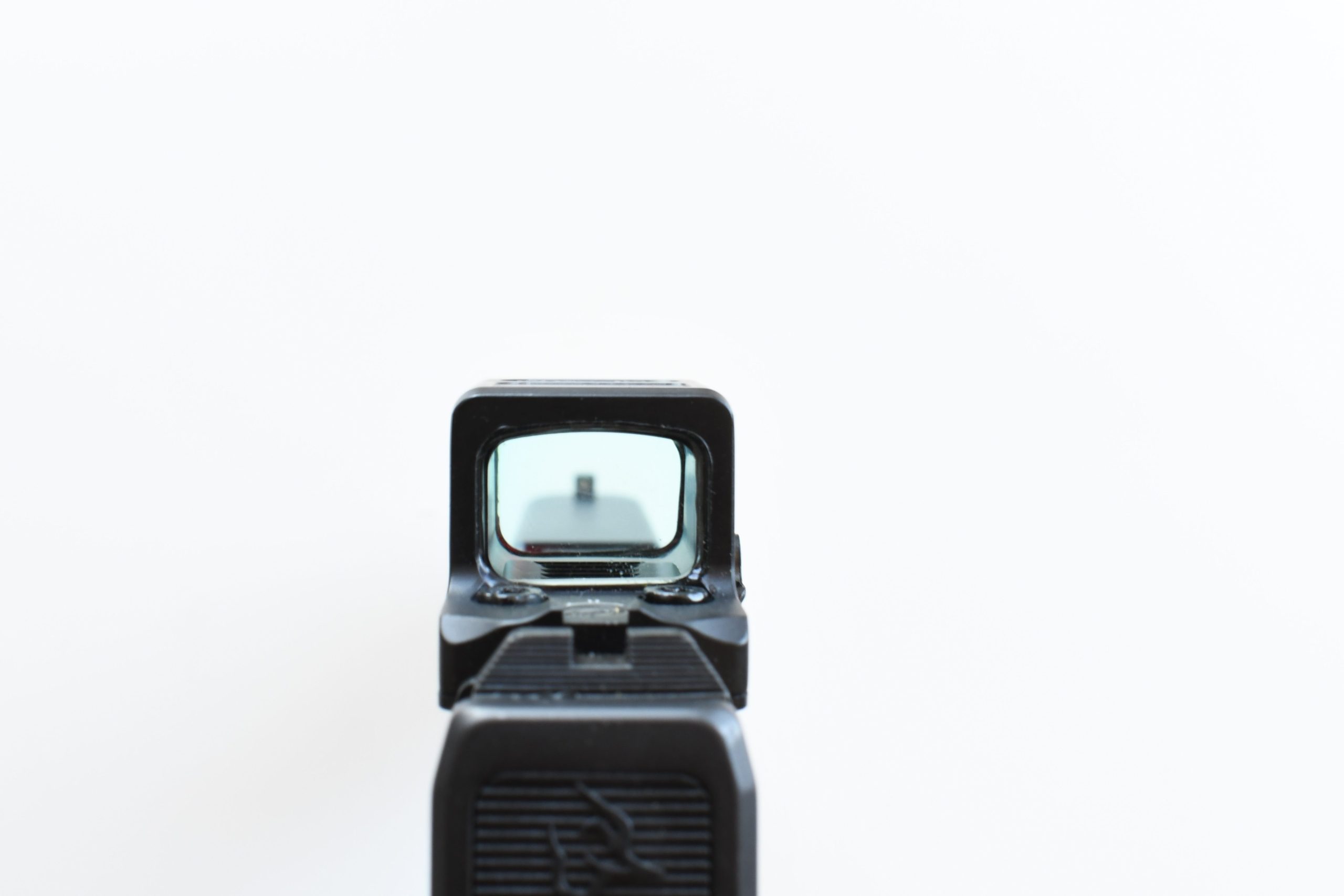
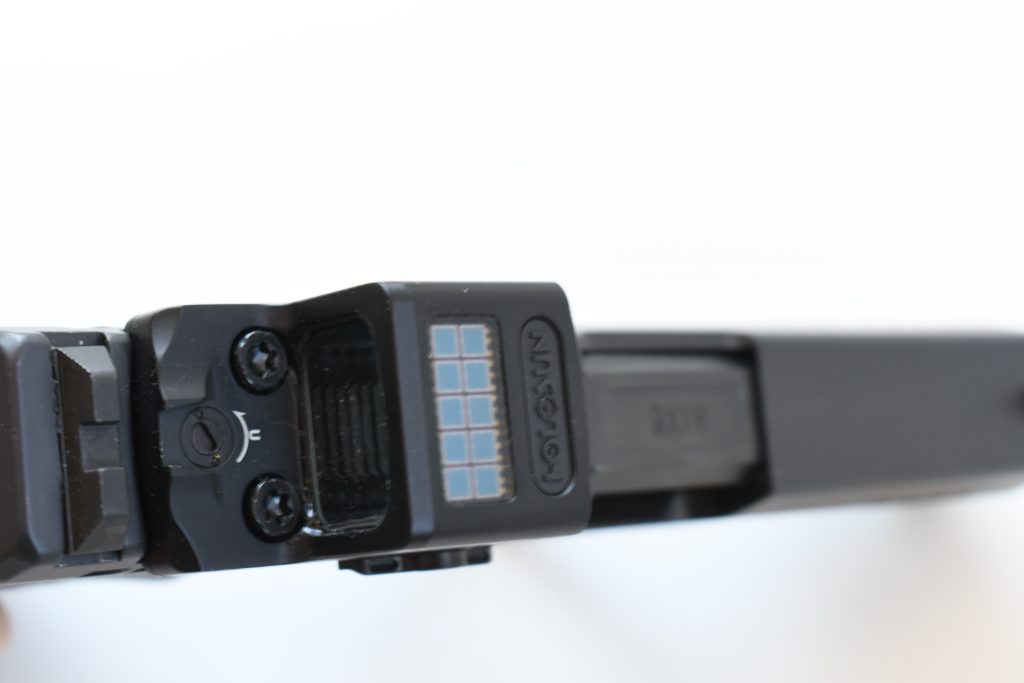
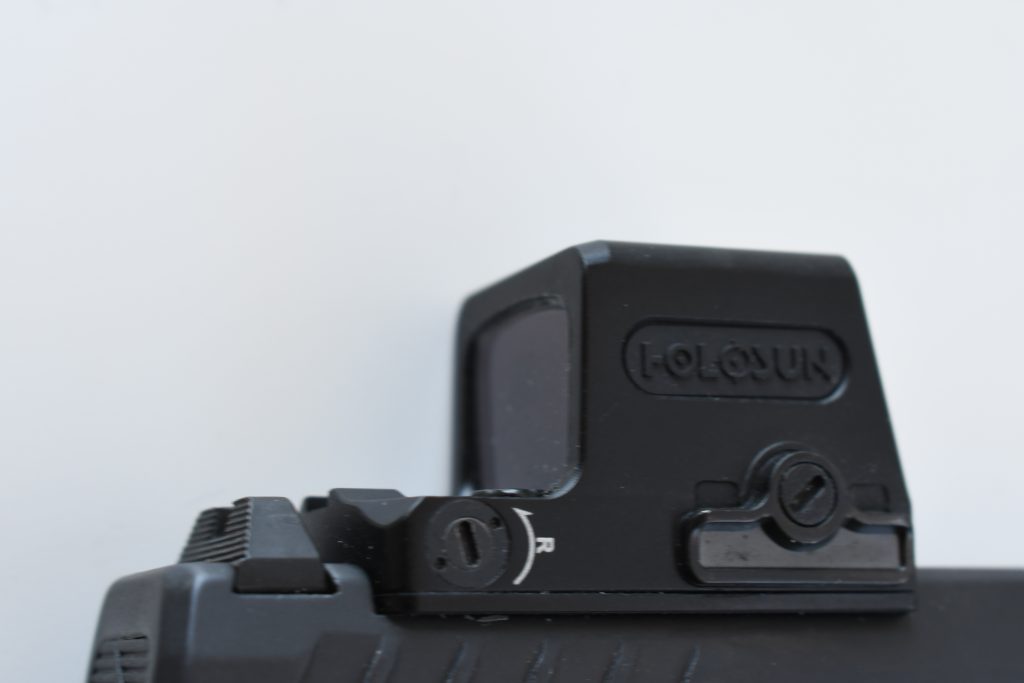
WHY ENCLOSED EMITTERS MATTER
All reflex sights big or small, work on a simple principle. They have an LED emitter which projects a beam at a coated lens (typically the coating gives off a bluish tint). This bluish tint allows all light to pass through, except specifically for the light projected by the emitter. The tint “catches” the beam and makes it reflects back to the human eye. That reflection serves as an aiming point. The majority of slide mounted reflex sights have a single lens with an emitter at the rear of the unit. For recreational or competitive shooting, these designs are fine. However open emitter sights run the risk of catching everything from water, dirt, mud, lint, snow or any other element which block or disrupt the projection towards the lens. An enclosed emitter reflex sight mitigates that risk by having the emitter inside a “box” with a front and rear lens that seals off the LED array from any external elements. For obvious reasons, such a design is preferable for duty-use, personal protection or other serious tasks. This is partially why the EPS Carry itself received so much fanfare during its initial launch. As the smallest closed emitter reflex sight currently available, it has much to offer to anyone serious about carrying with a dot.
SHOOTING WITH THE EPS CARRY
My experience with the Holosun EPS Carry (to date) has specifically been tied to shooting with the 9mm Taurus GX4XL. Having now sent rounds downrange through a multitude of pistol mounted reflex sights including other Holosun models, the Trijicon SRO and Steiner MPS, there was nothing negative that stood out to me about the EPS Carry. Even though this sight is the smallest one I’ve ever shot with, my experience was not interrupted or altered. If anything, having the EPS Carry enhanced my experience with the Taurus GX4XL, which as a sub-compact 9mm is more challenging to shoot than, say, my beloved CZ Shadow 2 or the full-size Walther PDP.
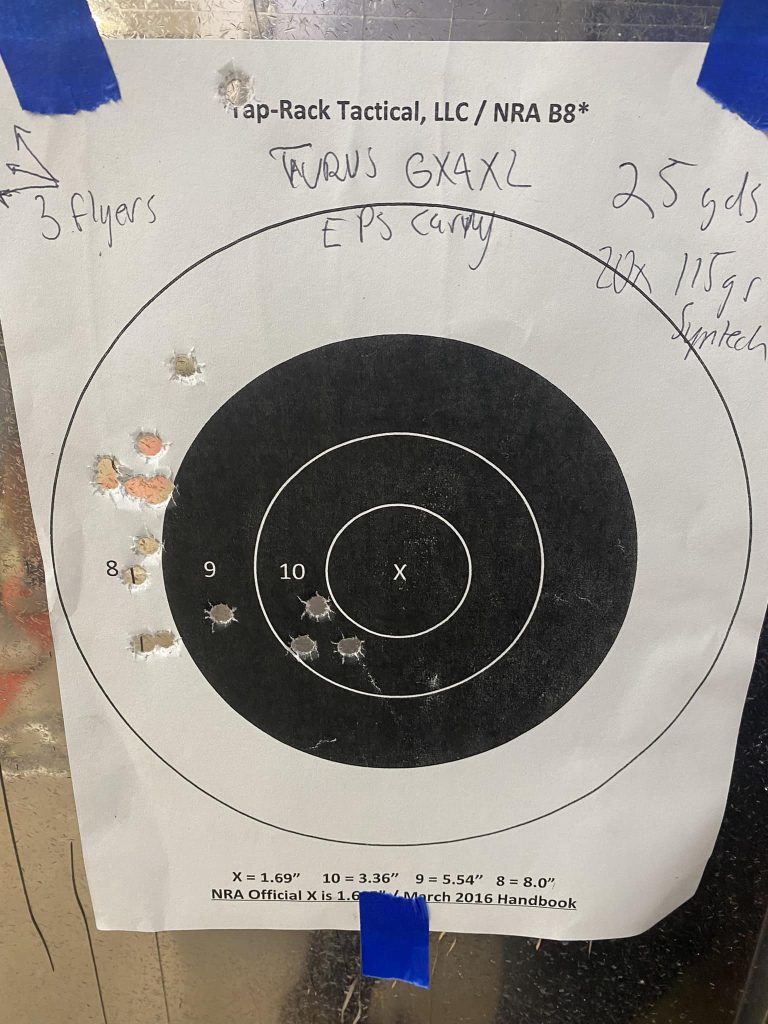
Though I hesitate to call this an issue, I noticed a tiny amount of distortion when not looking directly square into the middle of the window. If the shooter’s eyes perceive the reticle towards the top or bottom edge of the window, the 32 MOA ring will change shape and appear more like an oval. The central 2 MOA dot is not affected. Again, this is benign and Holosun does build these with aspheric lenses to help mitigate distortion. After all, we are talking about the smallest fully enclosed emitter sight on the market. Besides this negligible and slight distortion, the sight works as intended and shooting through it is no different than shooting a standard size slide mounted reflex sight. Ever since I got my hands on the EPS Carry and the Taurus GX4XL, I started imagining how nifty it would be to have a sight of this size on a full-size carry gun, like a Glock 19 or my Glock 45. Not only is the emitter enclosed and protected from the elements but the concealed carrier benefits from having a shooting aid that is very compact and doesn’t get in the way. After all, if it’s cool on the GX4XL, a Glock 48 or a Sig P365XL, why not a 19? Just because the EPS Carry was designed around slimilines doesn’t mean it needs to stay there.
For those interested in a direct comparison between the EPS and EPS Carry, here is a quick and dirty link I found.
The Beretta Tomcat – Not For Everyone
The Beretta tip-up barrel series is all kinds of cool. The tip-up barrel action is just neat, and the fact they look like miniaturized Beretta 92FS pistols lends to a sense of cuteness. The fact they have names like Tomcat, Bobcat, and Minx lends to their cool factor as well. Of those three guns, if I had to suggest one to the masses, it would be the Bobcat. The Minx is out of production, and the Tomcat just isn’t for everyone.
The Bobcat is a .22LR pistol with a tip-up barrel, various finish options, and even threaded barrel designs. To be fair, there was a .25 ACP bobcat, but it also seems to be out of production. The .22LR variant is very soft shooting and overall a ton of fun, so what’s wrong with its bigger brother, the Tomcat? The little .32 ACP pistol is seemingly just as cool and unique.
How the Tomcat Stands Out
The pistol came out in 1996, and for that era, it was fairly small. This was well before the rise of the polymer frame pocket pistol. We didn’t have the LCP, the S&W Bodyguard, or any other pocket .380 ACP on the market. Compared to those guns, it’s a bit large and heavy but still pocketable.
Beretta had been using the tip-up barrel design since 1952 with the advent of the Beretta 950. That old .25 ACP laid the groundwork for the various Beretta mini pistols. The Tomcat wears the famed tip-up barrel.
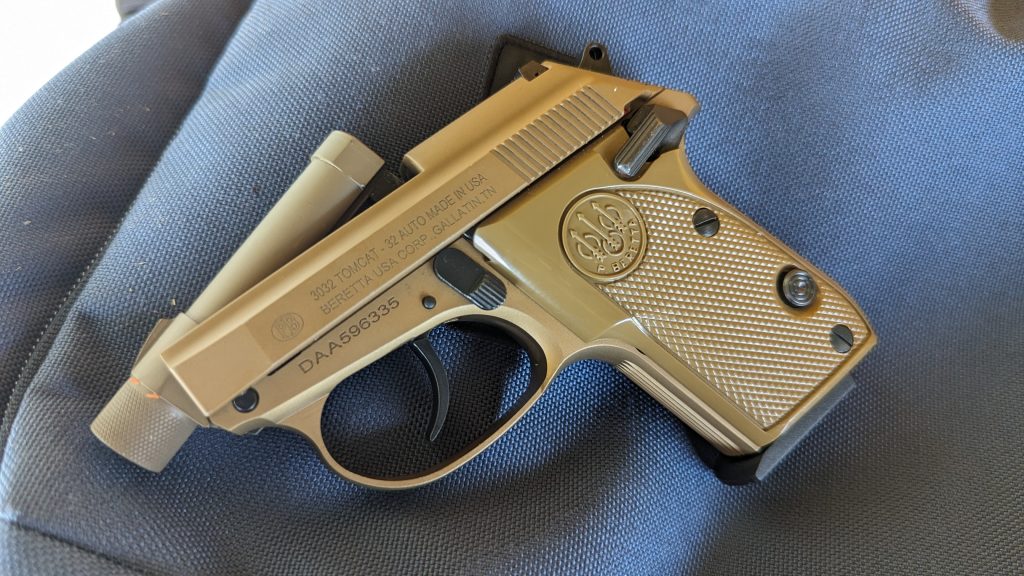
This provides shooters with an easy way to load the first round into the chamber. These guns utilize a straight blowback design with a very stiff recoil spring. A stiff recoil spring paired with a teeny tiny slide makes the gun tougher than average to rack.
The Tomcat is also a .32 ACP handgun, which is fairly rare for this era. We’ve seemed to settle on hurting our hands with pocket .380s for no real gain in ballistic potential. I have a whole rant on why .32 ACP is a better option than .380 ACP.
The Tomcat is one of the few pocket pistols that use a DA/SA trigger system. That’s likely why the grip is so thick for such a small gun. We have a manual safety, and the gun can be carried, locked, and cocked. The magazine release is a button, but it’s placed on the bottom and rear of the grip.
At the Range
Direct blowback guns are never fun, and the Tomcat could be a lot worse if it was in a larger caliber. The little .32 ACP isn’t rough, and the 1.1-inch thick grip helps absorb some of that recoil. We get a stiff recoil impulse that’s a bit worse than other small .32 ACPs I’ve fired. The worst part about the shooting experience was the slide bite and the slide cutting my wee little hand open.
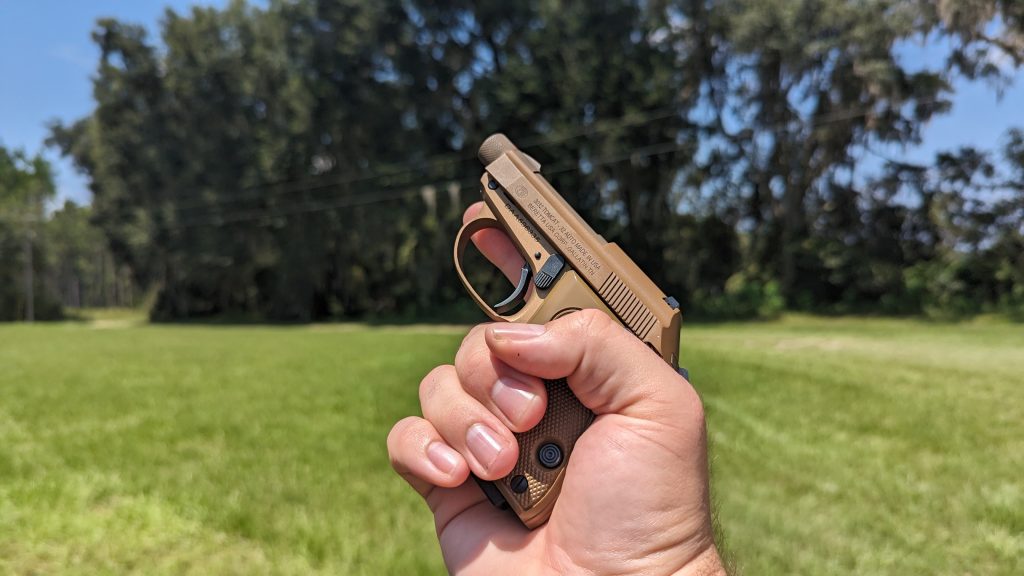
The double-action trigger pull is exceptionally long and heavy. It’s not what Beretta is typically known for, and it is a bit disappointing. Luckily, if you like the extra security of a double action trigger to help avoid negligent discharges, you get it in spades.
The single action is nice, and paired with actual sights, we get a fairly accurate handgun that makes it easy to put those 32 ACP pills right where you want them. Every B8 gets the black shot out of it! You can keep shooting because the gun is plenty reliable. I never ran into any malfunctions, and the blowback operation is well known for its reliability.
Why It Isn’t For Everyone
Ultimately, it sounds like a gun with some quirks, like a heavy trigger and slide bite, but why isn’t the Tomcat a gun I’d suggest for most shooters? There are a few reasons. First, it’s a bit out of date for practical carry. It’s 1.1 inches wide, making it thicker than my P365. It also weighs 14.5 ounces, making it only three ounces lighter than my P365.
It is smaller, but it’s a bit awkward with most pocket holsters. It’s too thick for the smallest but too small for bigger options. You have to search around a bit to find one that works.
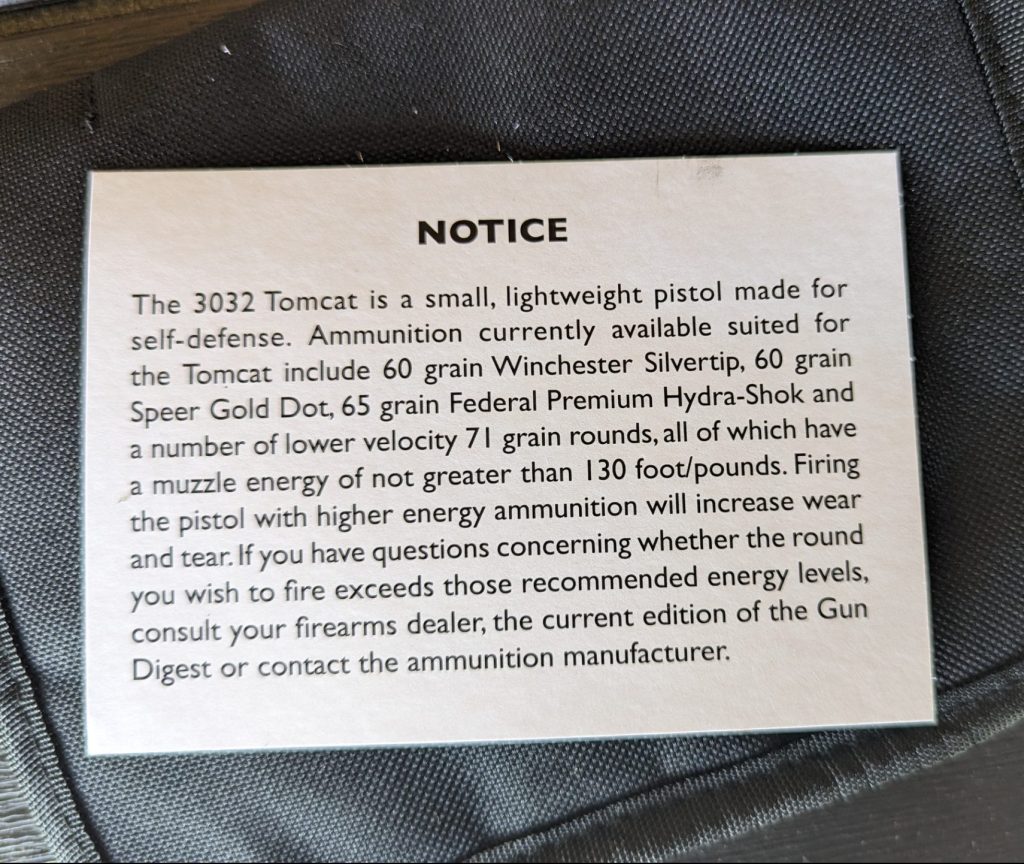
It’s also ammo-sensitive to a degree most aren’t accustomed to. Beretta includes a little flyer in the box stating that if you use 32 ACP ammo that exceeds 129 foot-pounds, your gun will break. Tomcats have long had frame cracking issues if you aren’t careful what ammo you put through the gun.
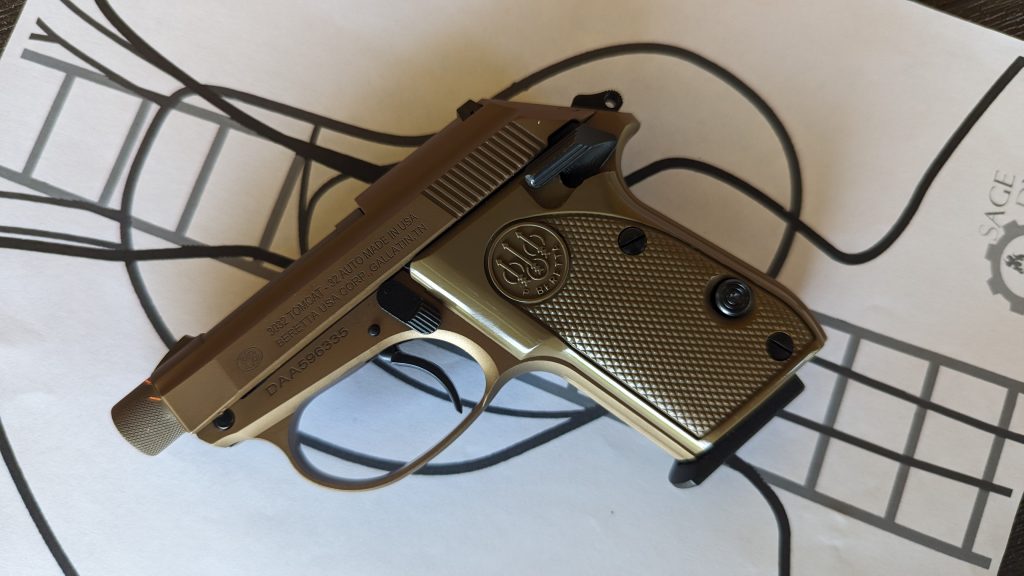
On top of a rather high price point, I don’t suggest this gun to many people. If you’re a gun nerd, it’s an interesting oddity. If you’re looking for a serious self-defense and concealed carry firearm, there are better options. This certainly isn’t for new gun owners. If you really want a Tomcat, I would suggest the .22LR Bobcat instead.
If you remain convinced you want a Tomcat because you love the look, feel, and uniqueness, then you won’t be disappointed.
The Pale Blue CR123A Rechargeable Batteries
If you are a gun nut, you likely need batteries like you need ammo. Lights, nods, and lasers don’t run on hopes and dreams. The most common type of disposable in the tactical world is the CR123A battery. It’s small, powerful, and modern. They are also expensive. To help cut costs and hopefully keep landfills battery-free, a company called Pale Blue produces rechargeable batteries and only recently introduced a CR123A battery option. With a four-pack running 34.99, it’s easy to see why these can be a great replacement for at least some of your CR123A batteries.
That is, if they work. I have a set of the Pale Blue CR123As and have been testing them quite a bit. The setup they come in is fairly nice, with a plastic carrying case that will tote your batteries and charger. The charger is a multi-head USB-C design that allows you to charge four batteries at a time. It’s a slick setup, and I set out to see if the function can follow form.
The Pale Blue Basics
The Pale Blue batteries are basic 3V batteries that can last at least 1,000 charges. They charge via a USB-A to USB-C charger, so it’s fairly quick, and the lot of them can be charged in about 100 minutes. These are lithium-ion batteries. They have a protection circuit to protect your battery and device so the battery will not overheat.
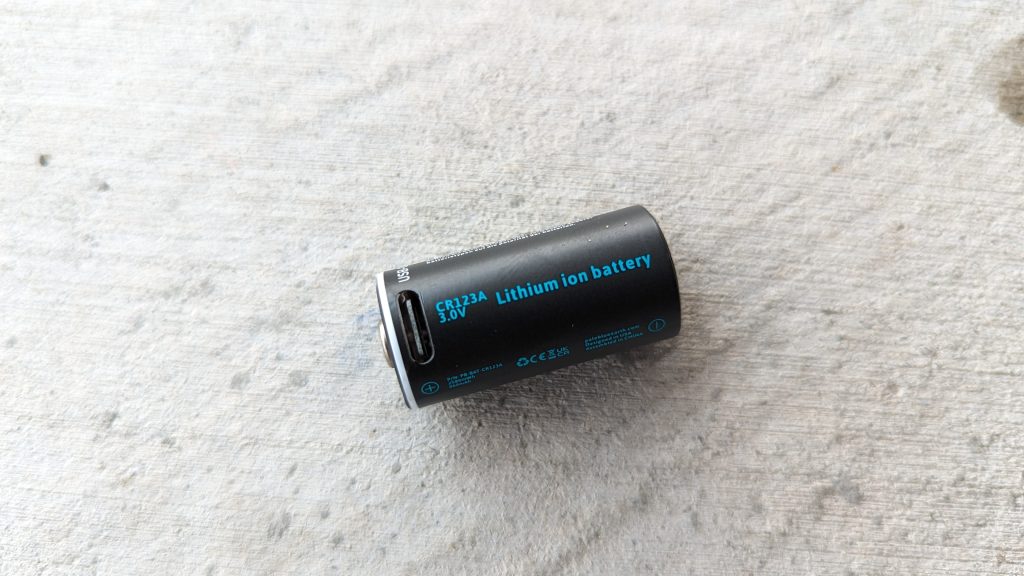
The main reason the pale Blue batteries interest me is because of the price and cost savings. A pack of Duracell CR123A batteries costs 36 bucks for 12 of them. That equals three bucks per battery. For about the same price, I’m getting four batteries that can be used 1,000 times. That’s a fairly nice cost-saving measure for the flashlights and WMLs.
Do They Work
I grabbed a couple of different Streamlights that I use fairly often. One being a TL RM1 and a basic Protac handheld. I’ve used them enough to know what to expect out of their battery life. I plopped the batteries in and started measuring their life span. I started with the Protac and knew the battery life was three hours, so I ran the light continuously under a stopwatch. It lasted three hours and 17 minutes and predictably had some power loss throughout the testing procedure.
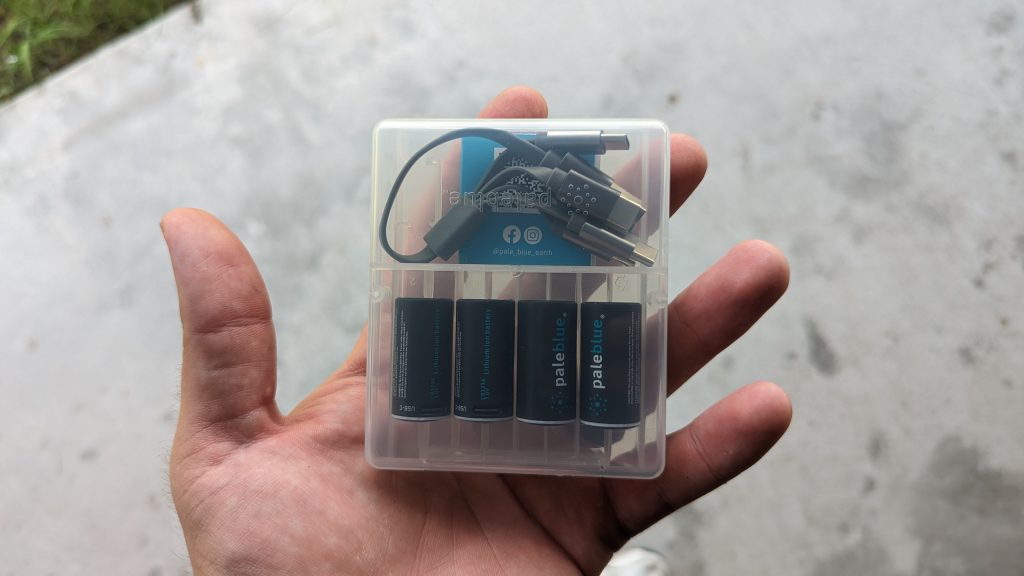
In the TL RM1, I used it in a bit more of a traditional weapon light role. I’ve been doing some low-light dry fire and practicing snapping the light on, firing a shot, and turning it off. I practiced for 10 to 15 minutes a night, working the light intermittently. It wasn’t on the entire ten to fifteen minutes, but it was used heavily. It took two weeks before I discovered a noticeable drop in power as the batteries lowered.
The runtime of the light is about 90 minutes. It’s not bad by any means and seemingly on point with battery life expectations. The Pale Blue batteries put out power and did so well within what we expect from CR123A. What happens if my batteries die in the field?
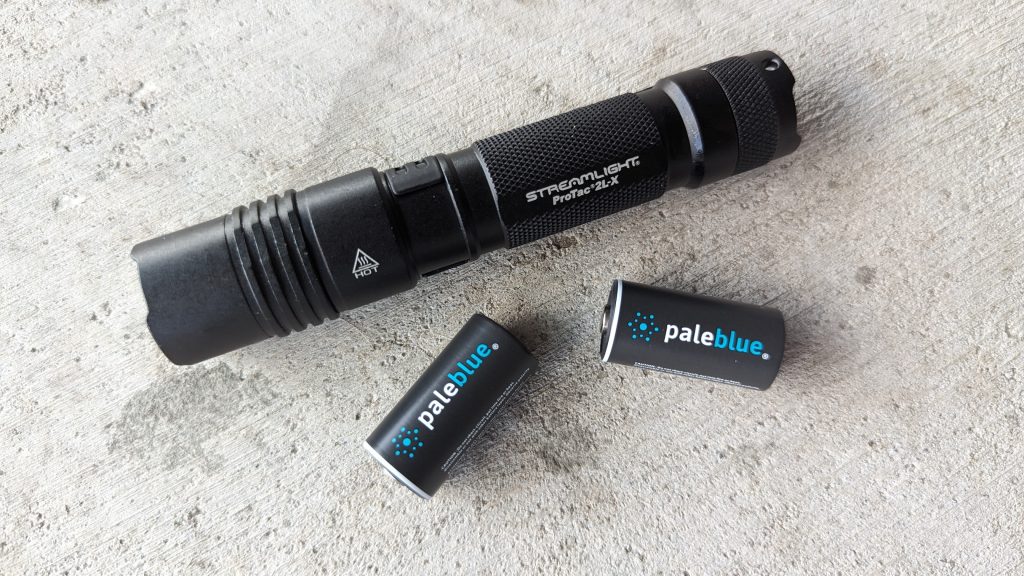
Owning rechargeable batteries doesn’t mean I can’t keep some disposables on tap to change out. To be fair, I’m not in any field where this would be a lifesaving measure, but for those who are, they are still a valid option.
Getting Pale
The CR123A batteries are perfect for nearly every one of my weapon lights. If you are using something high-power that specifically advises against CR123As, like an OWL, then you should still stick to the recommended batteries. Don’t use these to replace 18650s or 18350s in devices not designed for CR123As.
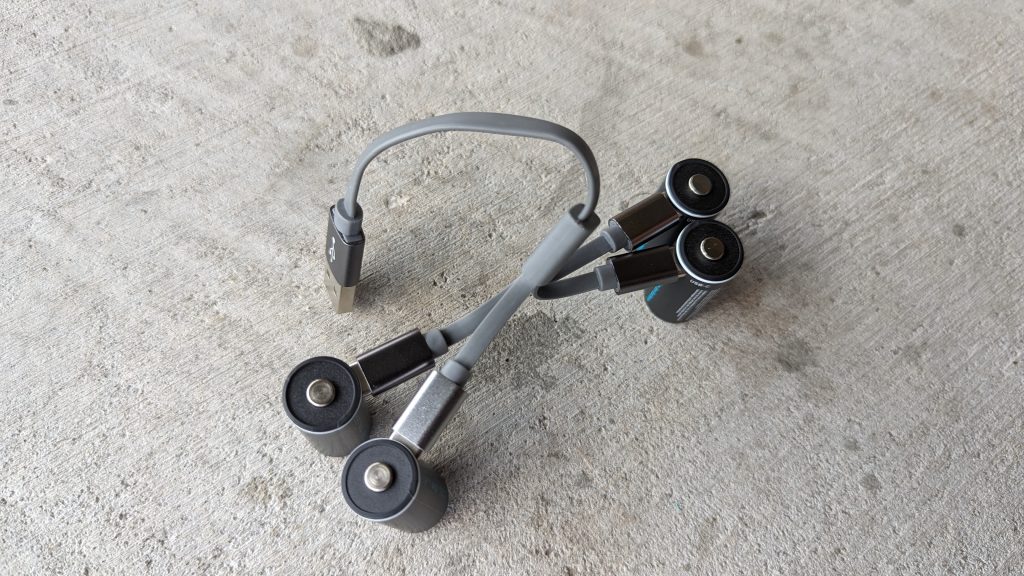
I don’t think they can make a CR2032 or 2016 rechargeable, but if they did, all my tactical battery needs would be taken care of. Pale Blue has a winner with these CR123As, and I think they are a worthwhile investment.
Haley Strategic Target Package – Free Stuff!
The phrase target package can be quite loaded. When I say Haley Strategic Target package, I’m not referring to a nondescript manilla folder full of information to take out a high-value target. I’m talking about a .zip folder with some printable PDF targets for fun at the range. Well, fun and training. I randomly found these, even though they’ve apparently been around since 2015ish. I like free stuff, and targets are free as long as you print them at the GAT offices.
What’s Inside the Haley Strategic Target Package
- The Haley Strategic Target package consists of the following targets:
- – Darkness Handheld Techniques Target
- – CET I Zero Target
- – Feel Eyes Finger Drill
- – CET I Kalash Target
- – Shift Gears Drill
- – Zero Dot Drill
- -Zero Dot Drill Carbine
Overall, it’s a variety of targets that aim mostly at training. Obviously, the Zero targets are just that, and they tend to be quite handy. The zero targets have quickly become my new favorite zero-target option. Now, instead of buying the bulk brand Walmart variants, I can just print a few with each new optic I have to test.
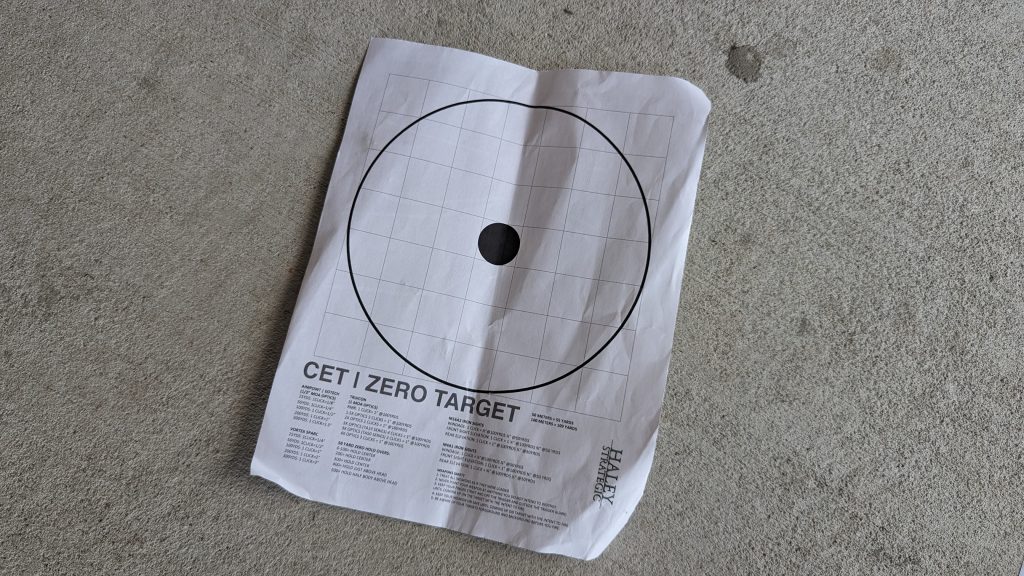
I printed all of these, but the Kalash model. I don’t have a Kalash I need to zero. Each target can be used for a variety of training drills, but a few have designated drills that are interesting and dynamic. Let’s dive into my favorite.

The Feel Eyes Finger Drill
This Haley Strategic target is made up of five lines of 1-inch dots. Each line has five dots. There are three ways listed to train with this drill. I’ll just cover the first today.
The first method of training uses all five lines, starting from the top and working your way down. This drill is started at three yards, and experienced shooters can step it out to seven yards. This portion is all about training.
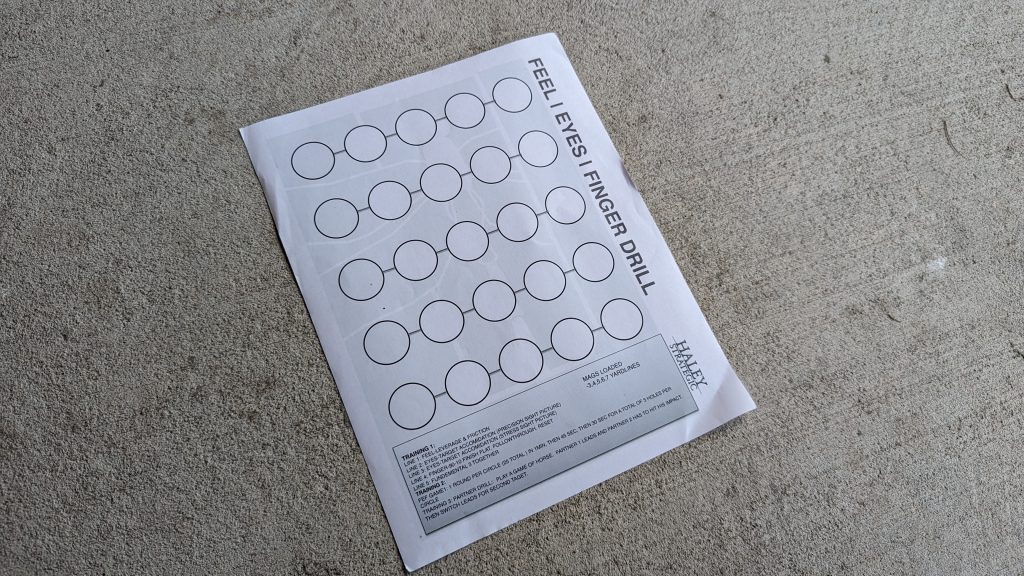
Line 1 Feel – This line has you focusing on the leverage and friction of your grip. Place the carpal of your support hand into the metacarpal of your firing hand. Squeeze the palms together. Fire one round per dot, focusing on pulling the trigger perfectly to the rear.
Line 2 Eyes – Here, we focus on establishing a perfect sight picture. A precision sight picture. Fire one round per dot.
Line 3 Eyes V2 – Here, we are going to use a stress sight picture. With this sight picture, we align the sights but focus on the threat. Our threat is clear, and our sights are blurry. Fire one shot per dot.
Line 4 Finger – This uses the Haley Strategic 90-10-Finish principle. This principle states we pull the trigger as flat as possible, directly to the rear. The first 90 percent is important, but not as important as the last 10%. For the last 10%, practice pulling it to the rear without disruption. Shoot each dot one time using this technique.
Line 5 Finisher – Combine all of the above techniques with your sight picture of choice and shoot the final five targets.
Going Beyond
That’s my favorite of the Haley Strategic target package, but it’s not the only one. The Changing Gears are fun to improve speed and precision, and the Zero Dot drills are great for figuring out your natural point of aim.
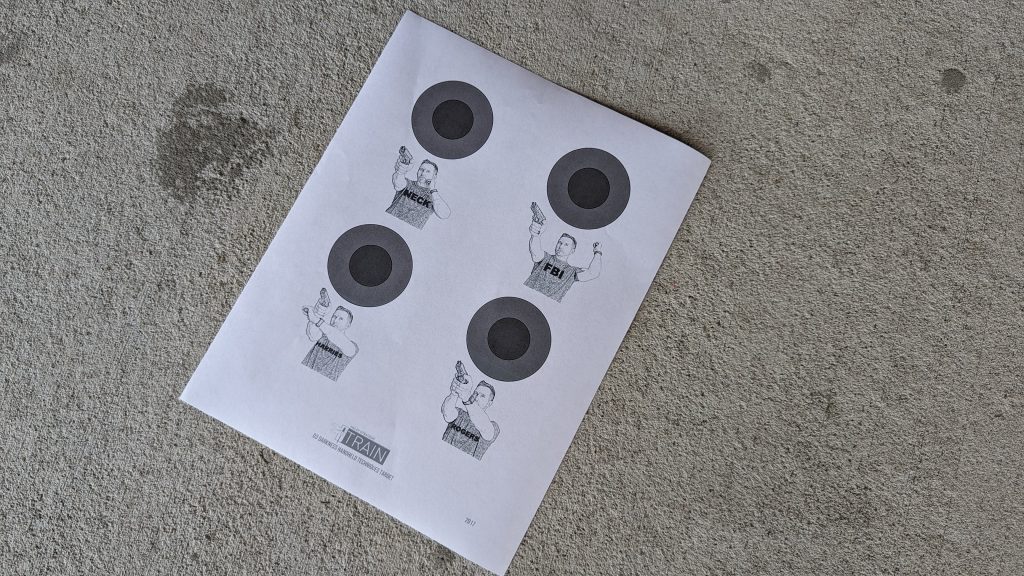
The Darkness Handheld Techniques Target has you trying the various light holds available while shooting small targets. It’s plenty of fun, especially since I’ve been practicing my handheld light practice a good bit. Check out the Haley Strategic Target here and get after it.
Bruen is earning its keep.
The post Bruen legal field has been stocked well with left leaning states passing fairly aggressive gun control packages and them being knocked down, enjoined, halted, and so forth in various legal challenge after legal challenge. Ultimately I don’t know what the political capital end state is for these politicians and lobbyists in the gun control camps, but I don’t know if their efforts are going to carry enough favor with their base to be profitable.
It feels, and this could be a misconception on my end, that the gun control advocate class cannot accept the sinking ship they inhabit. Gun laws are increasingly being axed if they do anything much beyond penalize a deliberately violent behavior. That isn’t universal and several places, like Maryland more recently, are going through a finding session of where and when a state can regulate the carry of a firearm. Other states are passing and losing things like assault weapon and magazine bans as the obvious gets stated for them in legal terms.
All of these events feel slated to push to the Supreme Court where the court will have to weigh in continuously on the different variations of nonsense liberal leaning states keep passing in the name of safety as they then spin a 180 and ignore high crime hot spots. They passed the laws, the extremist gun crazy conservatives who are owned by the NRA for fractions of a penny on the dollar are at fault, right?
People are becoming increasingly tired of the dog and pony show at both ends, even diehard gun controllers are sick of the lack of efficacy and progress while gun controller political types seem to be just riding the popularity of saying they will do something and the next thing will totally work, they promise. Gavin Newsom seems to be highest the that stack of political animals at the moment, passing a slew of laws that he feels will be challenged and defeated in court instead of doing his sworn duties to the Federal and State constitutions, as well as the electorate, and veto the laws until something constitutional crosses his desk. Nah, tie up the courts with garbage so you can ‘do something’ about gun violence.
New York’s Concealed Carry Improvement Act is doing the opposite, as is tradition of New York legislation like the SAFE Act making nobody any safer.
New Mexico’s gun control ‘Health Order’ out of the executive office keeps getting revised as the Governor keeps getting reminded she can’t do that.
Connecticut just banned open carry and limited the number of pistols that can be bought by an individual to three per 30 days. Where this will prevent mass shootings, limit straw purchasing and flipping, or otherwise styme the firearm pipeline I would be curious to see a shred of evidence.
Anyway, let’s go. Lawsuits in overdrive.
AR-15 Lower Receivers: Materials, Choices, and Quality
When embarking on the journey of building or upgrading an AR-15, a crucial decision lies in selecting the appropriate lower receiver. The AR-15, with its deep-rooted history spanning multiple generations, has led to an expansive range of options available in the market. These range from the traditional MIL-SPEC designs to the modern, ambidextrous, and visually appealing variants.
Choosing a lower receiver involves carefully considering its manufacturing process, the materials used, and weight factors, all while keeping in mind one’s budget and functional requirements.
Let’s delve into the development and nuances of AR-15 lower receivers. We’ll also highlight some notable offerings available in the market. Here’s a guide for those new to the AR-15 world, those considering an upgrade, or those simply keen on enhancing their knowledge.
Exploring Lower Receiver Materials
A closer look at lower receiver materials reveals three primary types: cast aluminum, billet aluminum, and forged aluminum.
Cast Aluminum
The manufacturing process for cast aluminum is relatively simple. It entails pouring molten aluminum into a mold. Once cooled, the resulting lower receiver undergoes final machining.
The liquid state of the aluminum during casting leads to a product with a somewhat loose crystalline structure. This method results in the least sturdy product among the three main aluminum processing techniques.
However, it’s worth mentioning that despite cast aluminum being perceived as the least strong among the trio, it offers sufficient strength for the lower receiver to operate safely and dependably. Still, when it comes to preferences, it’s often viewed as the less preferred method for crafting aluminum components.
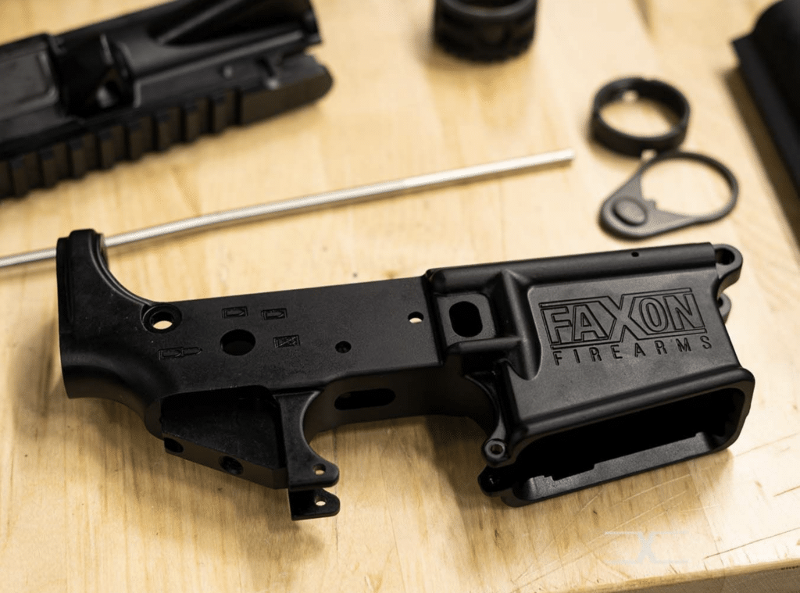
Billet Aluminum
Billet aluminum lower receivers start their journey as a solid block of aluminum, reminiscent of how a sculptor begins with a block of marble. This block is transformed into a finely crafted product through a series of precision machining operations.
Working with billet aluminum can be likened to metal sculpting, offering several advantages over the casting method. Due to their solid nature, billet lowers possess enhanced strength and showcase a superior finish.
For those aiming for a unique firearm aesthetic, billet lower receivers are ideal. Their design allows for extensive customization, enabling manufacturers to introduce distinctive features such as uniquely shaped magazine wells, integrated trigger guards, and specialized machining for weight optimization.
The creation of billet lower receivers primarily relies on CNC (Computer Numerical Control) machining. In this method, automated precision tools intricately shape a solid aluminum block, facilitating the production of detailed and highly personalized designs.
While billet lowers might carry a heftier price tag, their adaptability and visual allure make them a favorite among many. These receivers, crafted from billet aluminum and shaped by CNC machinery, are known for their crisp lines and the ability to achieve standout designs. Some aficionados even push the boundaries of design with these.
It’s important to highlight that although billet lowers are often perceived as less robust than forged lowers, this difference is typically invisible to the average user. They offer commendable durability and are unlikely to succumb to premature wear or damage. However, some uniquely designed billet lowers might have specific compatibility constraints. Therefore, ensuring their compatibility with standard MIL-SPEC components is crucial, especially if one intends to match them with a particular billet upper receiver.
Understanding 7075-T6 Aluminum
Two prominent contenders emerge in the spectrum of aluminum alloys used for lower receivers: 6061-T6 and 7075-T6. The primary distinction between these two lies in their strength and resistance to corrosion.
7075-T6 is characterized by its remarkable strength, surpassing 6061-T6 by almost double in this aspect. This difference in strength is reflected in the price, with 7075-T6 generally being the pricier of the two. However, it’s essential to recognize that 6061-T6 offers enhanced corrosion resistance compared to 7075-T6. While this resistance can be a significant advantage, its relevance might vary based on whether the receiver retains its natural aluminum appearance or undergoes specific finishing processes.
When planning your firearm assembly, balancing the need for superior strength against budgetary constraints is wise. The gap between 7075 and 6061 is relatively narrow in the current landscape. Nonetheless, many opt for the added assurance of 7075-T6’s robustness, making it a favored choice. Notably, 7075-T6 aluminum is frequently used in aerospace industries due to its outstanding strength-to-weight ratio and resilience, further emphasizing its reputation for dependability and longevity.
Complete Lower vs. Stripped Lower
Are you embarking on your first firearm project? You’ll likely encounter two primary options for lower receivers: stripped and complete. The inevitable question is, “What differentiates the two, and which is the better fit for me?” Let’s break down the distinctions to guide your decision.
Stripped Lower Receivers:
At first glance, stripped lower receivers might seem incomplete. They lack several vital components required for a fully operational lower receiver, such as the trigger, buffer tube, buffer, and stock.
So, why might one opt for a stripped lower receiver, given these omissions?
- Customization Galore: Stripped lowers offer unparalleled customization potential. You’re in the driver’s seat, handpicking each component to align with your vision.
- Budget-Friendly: Typically, stripped lowers are more wallet-friendly than their complete counterparts, making them an attractive option for budget-conscious builders.
- Deep Dive into Mechanics: Assembling a stripped lower offers a hands-on learning experience, granting a deeper appreciation for your rifle’s mechanics.
However, stripped lowers come with challenges:
- Labor Commitment: Crafting a stripped lower demands time and meticulous attention to detail, as each component requires careful installation.
- Tool Dependency: Essential tools, like punches and wrenches, are a must-have for assembling a stripped lower.
- Technical Know-How: A foundational understanding of firearm mechanics is crucial for a successful stripped lower assembly.
Complete Lower Receivers:
Conversely, complete lower receivers are ready to roll outfitted with all essential components. With a complete lower in hand, pairing it with an upper receiver is all that stands between you and a fully operational rifle.
Benefits of a complete lower receiver include:
- Utmost Convenience: Ideal for those short on time or lacking the expertise or tools for a stripped lower assembly.
- Time Efficiency: Pre-assembled components translate to significant time savings.
- Assured Compatibility: Components in a complete lower are designed to function seamlessly together, eliminating compatibility concerns.
Yet, complete lowers have their limitations:
- Customization Constraints: The pre-assembled nature restricts your ability to tweak individual components.
- Price Premium: The convenience of a pre-assembled unit often comes with a higher price tag.
- Missed Learning Opportunities: An already-assembled unit means fewer chances to delve into the intricacies of your firearm.
The decision between stripped and complete lower receivers boils down to individual preferences, expertise, and the desired balance between customization and convenience in your firearm project.
AR Lower Receiver Sets
In the vast landscape of AR lower receivers, Faxon‘s products have garnered attention for their quality and design. Let’s delve into one of their standout offerings.
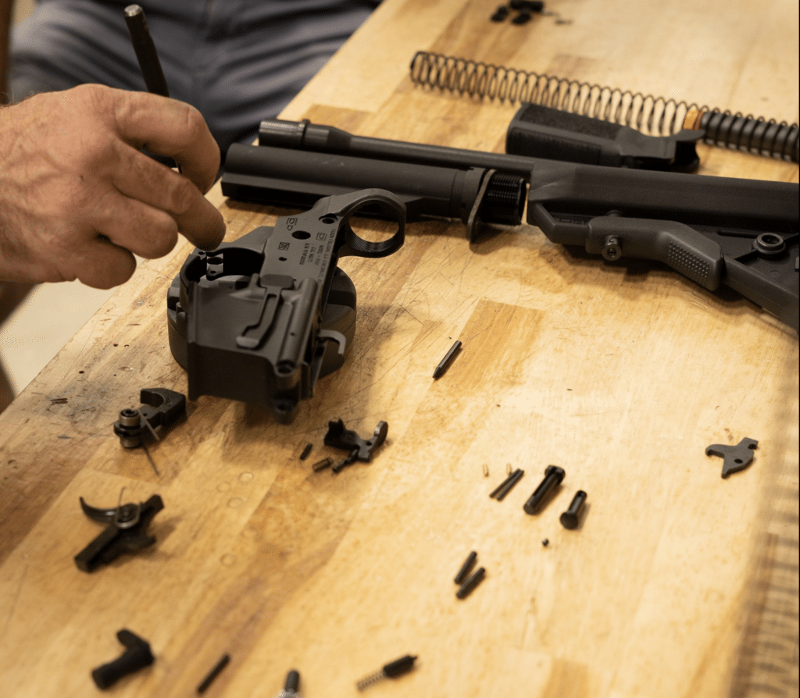
Faxon X-Tra Lite AR-15 Receiver Set
The Faxon HyperLite AR-15 Receiver Kit is a notable choice for those aiming for a lightweight yet robust build. Building upon the foundation of their acclaimed forged receiver set, this kit emphasizes a balance between aesthetics, functionality, and durability while significantly reducing weight.
Key Features:
- Weight Efficiency: When equipped with an ejection port and dust cover, the kit weighs a mere .96 lbs. This is 2.08 ounces lighter than Faxon’s standard forged receiver set.
- Precision Engineering: The inner bore is refined to enhance the bolt carrier group’s action, promoting smoother operations.
- Design Choices: The forward assist has been omitted for a cleaner look, while the skeletonized Picatinny Rail, with manually engraved T-marks, adds a touch of craftsmanship. The skeletonized shell deflector further trims the weight while ensuring durability.
- Fitment: Tighter lug tolerances ensure a snug fit, optimizing performance.
- Customization Opportunities: While the kit is delivered unassembled, its design allows enthusiasts to personalize their build. The aesthetic milling of the upper, adorned with Faxon’s signature “X” logo, reduces material and weight. The “X” skeletonized magwell is both a branding touch and a testament to Faxon’s dedication to weight efficiency.
- Material & Finish: Crafted from 7075-T6 Forged Aluminum and finished with Type III Hard Coat Anodizing.
The kit is also available in OD Green Cerakote, Titanium Cerakote, and Midnight Bronze for those interested in color variations. The Faxon HyperLite AR-15 Receiver Kit encapsulates a harmonious blend of design, functionality, and innovation, making it a worthy consideration for discerning builders.
Faxon Billet AR-10 Receiver Set
The Faxon Billet AR-10 Receiver Set stands as a testament to meticulous engineering and an unwavering commitment to quality. This set is tailored for discerning firearm enthusiasts seeking a comprehensive upgrade for their AR-10 rifle.
Material and Durability:
This set’s stripped upper and lower receivers are crafted from high-grade 7075-T6 aluminum billet. This choice of material ensures a balance between lightweight design and robust strength, making the set ideal for enduring rigorous use while maintaining reliability.
Design Highlights:
Faxon’s dedication to superior design is evident in several unique features:
- An integrated trigger guard enhances safety and ergonomics.
- A flared magwell facilitates quicker magazine changes, optimizing functionality during rapid-fire situations.
- A specialized tensioning screw ensures a tight fit between the upper and lower receivers, a crucial factor in boosting accuracy.
Upper Receiver Specifics:
- Made from 7075-T6 Billet Aluminum, ensuring durability without excess weight.
- Features a Type III Class 2 Hard Coat Black Anodized finish for added resilience and a polished look.
- Adheres to the DPMS High Profile standards, guaranteeing compatibility with various components.
Lower Receiver Details:
- It is also constructed from 7075-T6 Billet Aluminum, consistent with the upper receiver.
- Enhanced with features like an Extended Mag Catch Button, Threaded Bolt Catch Pin, and a Rear Takedown Detent Spring retained with a Set Screw. An Upper Receiver Tension Screw is also incorporated.
- The Right Side Bolt Release Lever, made from 4140 steel, undergoes a Blacknitride+™ treatment for increased longevity.
- While labeled with a “MULTI” caliber designation, it’s versatile enough to accommodate a range of calibers, including .308 Winchester (7.62x51mm NATO), 8.6 Blackout, .243 Winchester, 6.5 Creedmoor, .260 Remington, and .338 Federal.
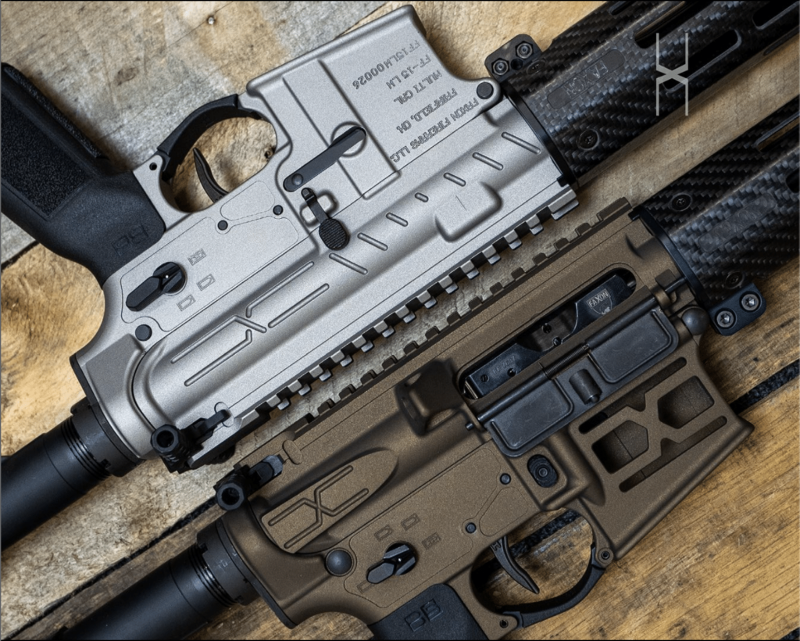
Exploring the Faxon AR-15 Builder Sets
Limited Edition Faxon 9″ AR-15 Builder Set – FDE
The Faxon AR-15 Builder Set in FDE (Flat Dark Earth) is a culmination of precision engineering and innovative design. With a custom Cerakote finish, this set offers both functionality and a distinctive aesthetic.
Key Features:
- Precision Engineered Upper Receiver: Undergoes a rigorous truing process at Faxon’s facility, ensuring alignment and balance.
- Design Innovations: Features like the hollowed-out shell deflector reduce weight and add a unique visual element.
- Material and Finish: Made from 7075-T6 Forged Aluminum, with a dual finish of Type III Hard Coat Anodizing and a custom Cerakote.
- Versatility: Compatible with all intermediate cartridges, with a note on the set’s capabilities with larger bore rounds.
- Included Handguard: The set comes with the Faxon G2 Streamline Aluminum M-LOK Handguard, emphasizing ergonomic design and style.
Limited Edition Faxon 13″ AR-15 Builder Set
This builder set showcases Faxon’s commitment to craftsmanship and design. A custom Cerakote finish in Combat Grey offers a blend of performance and aesthetics.
Key Features:
- Meticulously Crafted Upper Receiver: Trued by experts at Faxon’s factory, ensuring enhanced firearm performance.
- Design Elements: The hollowed-out shell deflector offers both aesthetic appeal and functional weight reduction.
- Material and Finish: Crafted from 7075-T6 Forged Aluminum, with a Type III Hard Coat Anodizing and a custom Cerakote finish.
- Versatility: Designed for compatibility with all intermediate cartridges, with a note on its performance with larger bore rounds.
- Included Handguard: The Faxon G2 Streamline Aluminum M-LOK Handguard complements the set.
*Also available in Charcoal Green.
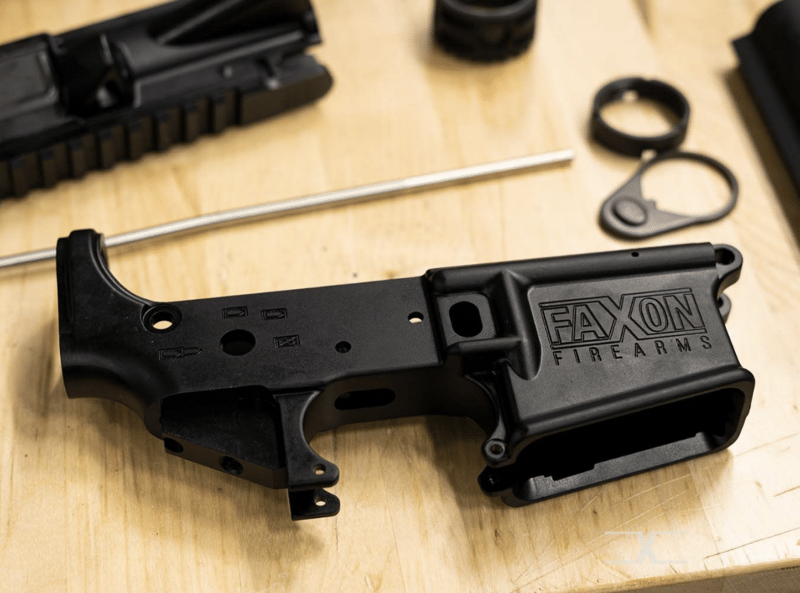
Wrapping up
Choosing the right lower receiver balances objectives, budget, and familiarity with AR-15 mechanics.
- Stripped vs. Complete: For those well-versed in AR-15 mechanics, a stripped lower receiver offers a tailored, hands-on experience. On the other hand, a complete lower receiver is ideal for those seeking convenience, requiring only attachment to the upper.
Quality Over Features: While additional features can be appealing, the cornerstone of a reliable AR-15 build is a quality lower.

